A Review of Successful Tourism Destinations
VerifiedAdded on 2020/10/04
|20
|6629
|140
AI Summary
The assignment reviews the concept of successful tourism destinations, highlighting the importance of factors such as accessibility, affordability, and authenticity. It also discusses the 10 As model of successful tourism destinations, which includes aspects such as attraction, amenities, awareness, access, accuracy, affective quality, spatial quality, temporal quality, price quality, and functional quality. The assignment provides case studies from around the world, including Hong Kong, the UK, and others, to illustrate the application of these factors in practice.
Contribute Materials
Your contribution can guide someone’s learning journey. Share your
documents today.
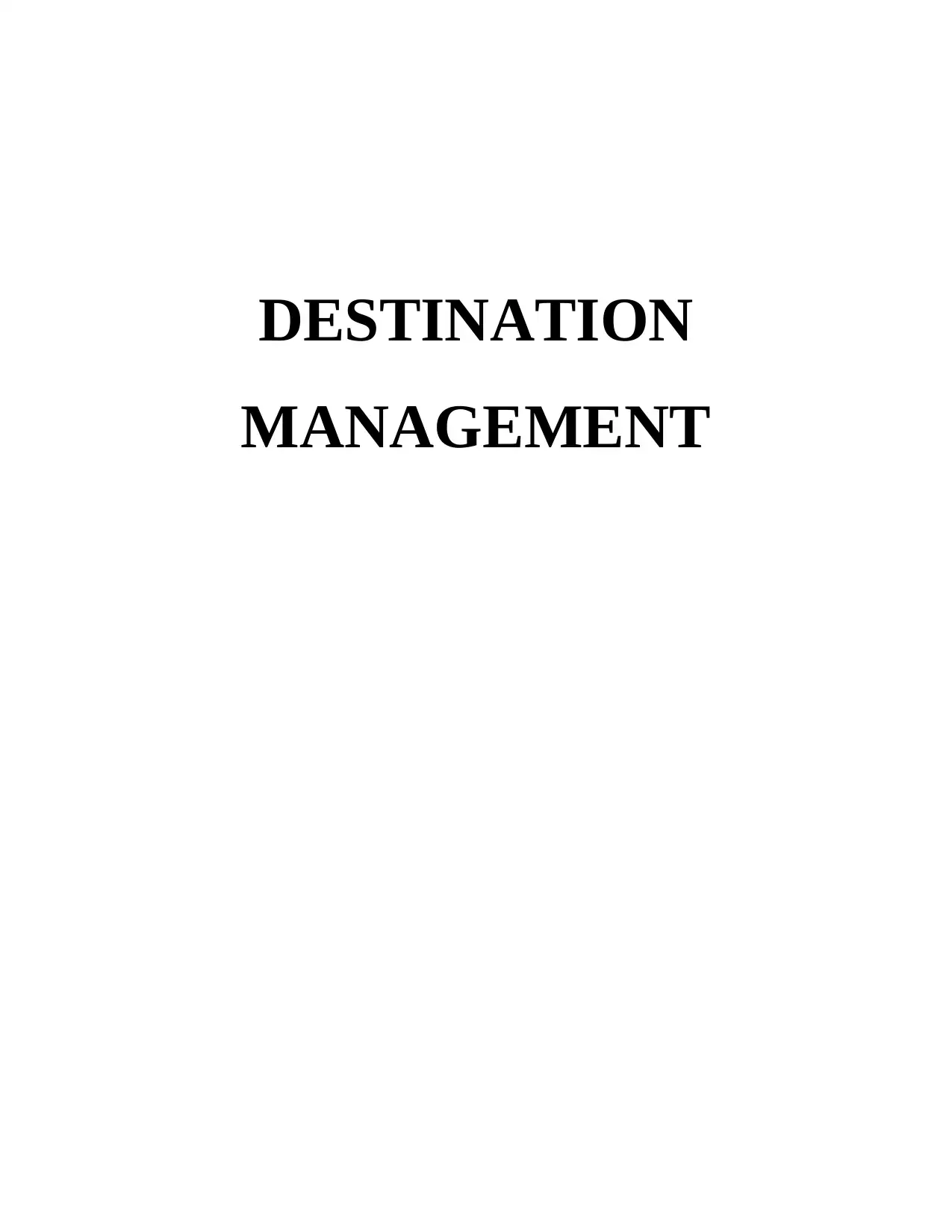
DESTINATION
MANAGEMENT
MANAGEMENT
Secure Best Marks with AI Grader
Need help grading? Try our AI Grader for instant feedback on your assignments.
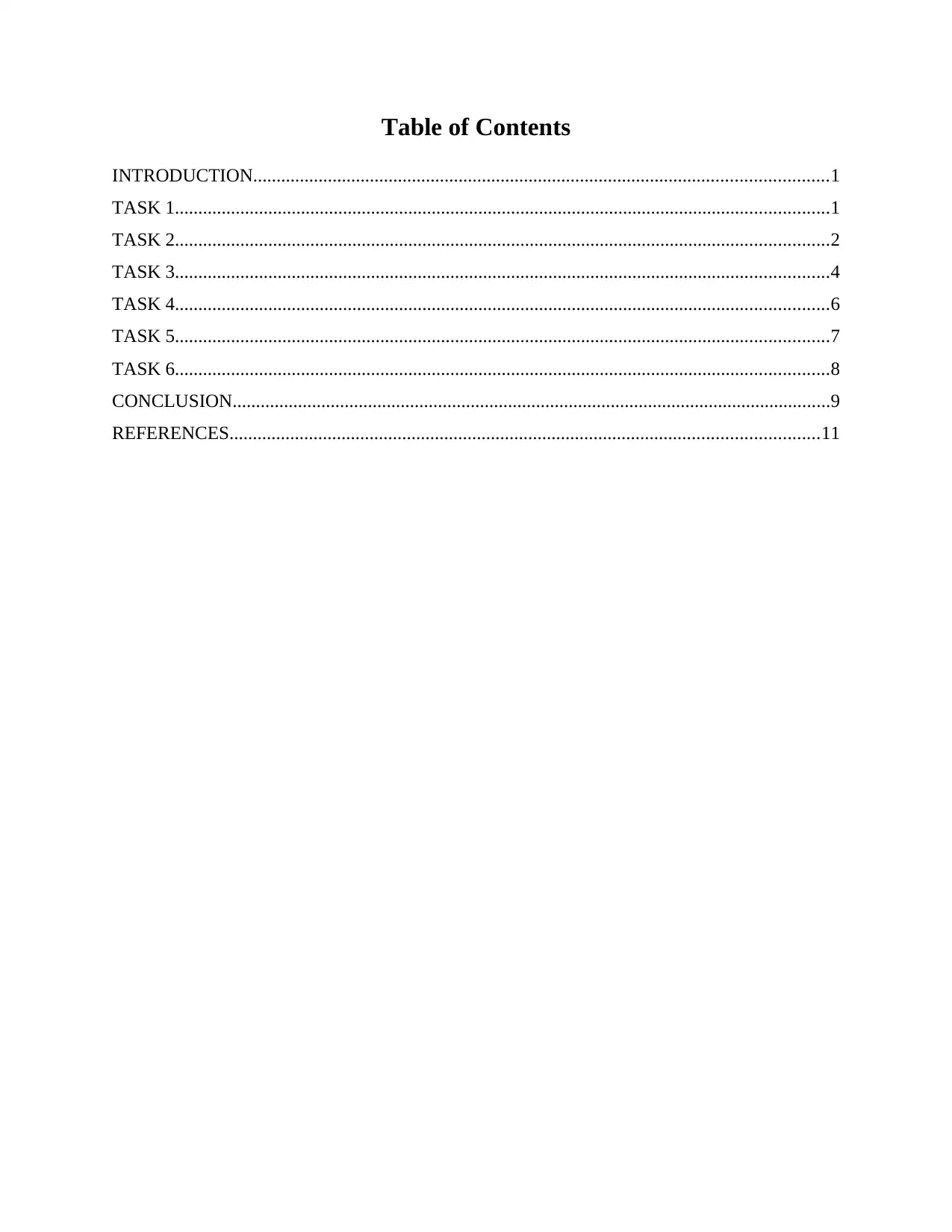
Table of Contents
INTRODUCTION...........................................................................................................................1
TASK 1............................................................................................................................................1
TASK 2............................................................................................................................................2
TASK 3............................................................................................................................................4
TASK 4............................................................................................................................................6
TASK 5............................................................................................................................................7
TASK 6............................................................................................................................................8
CONCLUSION................................................................................................................................9
REFERENCES..............................................................................................................................11
INTRODUCTION...........................................................................................................................1
TASK 1............................................................................................................................................1
TASK 2............................................................................................................................................2
TASK 3............................................................................................................................................4
TASK 4............................................................................................................................................6
TASK 5............................................................................................................................................7
TASK 6............................................................................................................................................8
CONCLUSION................................................................................................................................9
REFERENCES..............................................................................................................................11

Illustration Index
Illustration 1: Successful tourism destination..................................................................................3
Illustration 1: Successful tourism destination..................................................................................3
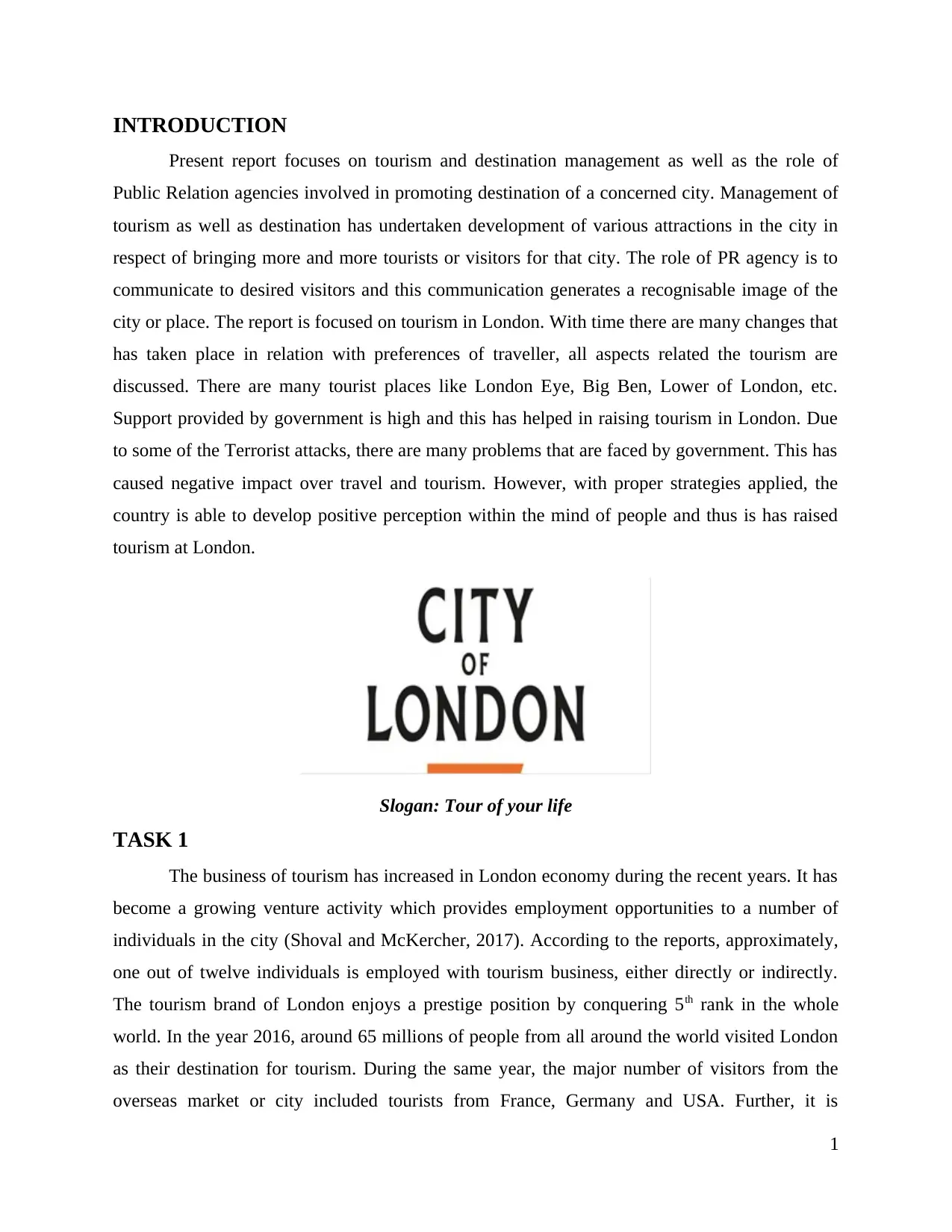
INTRODUCTION
Present report focuses on tourism and destination management as well as the role of
Public Relation agencies involved in promoting destination of a concerned city. Management of
tourism as well as destination has undertaken development of various attractions in the city in
respect of bringing more and more tourists or visitors for that city. The role of PR agency is to
communicate to desired visitors and this communication generates a recognisable image of the
city or place. The report is focused on tourism in London. With time there are many changes that
has taken place in relation with preferences of traveller, all aspects related the tourism are
discussed. There are many tourist places like London Eye, Big Ben, Lower of London, etc.
Support provided by government is high and this has helped in raising tourism in London. Due
to some of the Terrorist attacks, there are many problems that are faced by government. This has
caused negative impact over travel and tourism. However, with proper strategies applied, the
country is able to develop positive perception within the mind of people and thus is has raised
tourism at London.
Slogan: Tour of your life
TASK 1
The business of tourism has increased in London economy during the recent years. It has
become a growing venture activity which provides employment opportunities to a number of
individuals in the city (Shoval and McKercher, 2017). According to the reports, approximately,
one out of twelve individuals is employed with tourism business, either directly or indirectly.
The tourism brand of London enjoys a prestige position by conquering 5th rank in the whole
world. In the year 2016, around 65 millions of people from all around the world visited London
as their destination for tourism. During the same year, the major number of visitors from the
overseas market or city included tourists from France, Germany and USA. Further, it is
1
Present report focuses on tourism and destination management as well as the role of
Public Relation agencies involved in promoting destination of a concerned city. Management of
tourism as well as destination has undertaken development of various attractions in the city in
respect of bringing more and more tourists or visitors for that city. The role of PR agency is to
communicate to desired visitors and this communication generates a recognisable image of the
city or place. The report is focused on tourism in London. With time there are many changes that
has taken place in relation with preferences of traveller, all aspects related the tourism are
discussed. There are many tourist places like London Eye, Big Ben, Lower of London, etc.
Support provided by government is high and this has helped in raising tourism in London. Due
to some of the Terrorist attacks, there are many problems that are faced by government. This has
caused negative impact over travel and tourism. However, with proper strategies applied, the
country is able to develop positive perception within the mind of people and thus is has raised
tourism at London.
Slogan: Tour of your life
TASK 1
The business of tourism has increased in London economy during the recent years. It has
become a growing venture activity which provides employment opportunities to a number of
individuals in the city (Shoval and McKercher, 2017). According to the reports, approximately,
one out of twelve individuals is employed with tourism business, either directly or indirectly.
The tourism brand of London enjoys a prestige position by conquering 5th rank in the whole
world. In the year 2016, around 65 millions of people from all around the world visited London
as their destination for tourism. During the same year, the major number of visitors from the
overseas market or city included tourists from France, Germany and USA. Further, it is
1
Paraphrase This Document
Need a fresh take? Get an instant paraphrase of this document with our AI Paraphraser
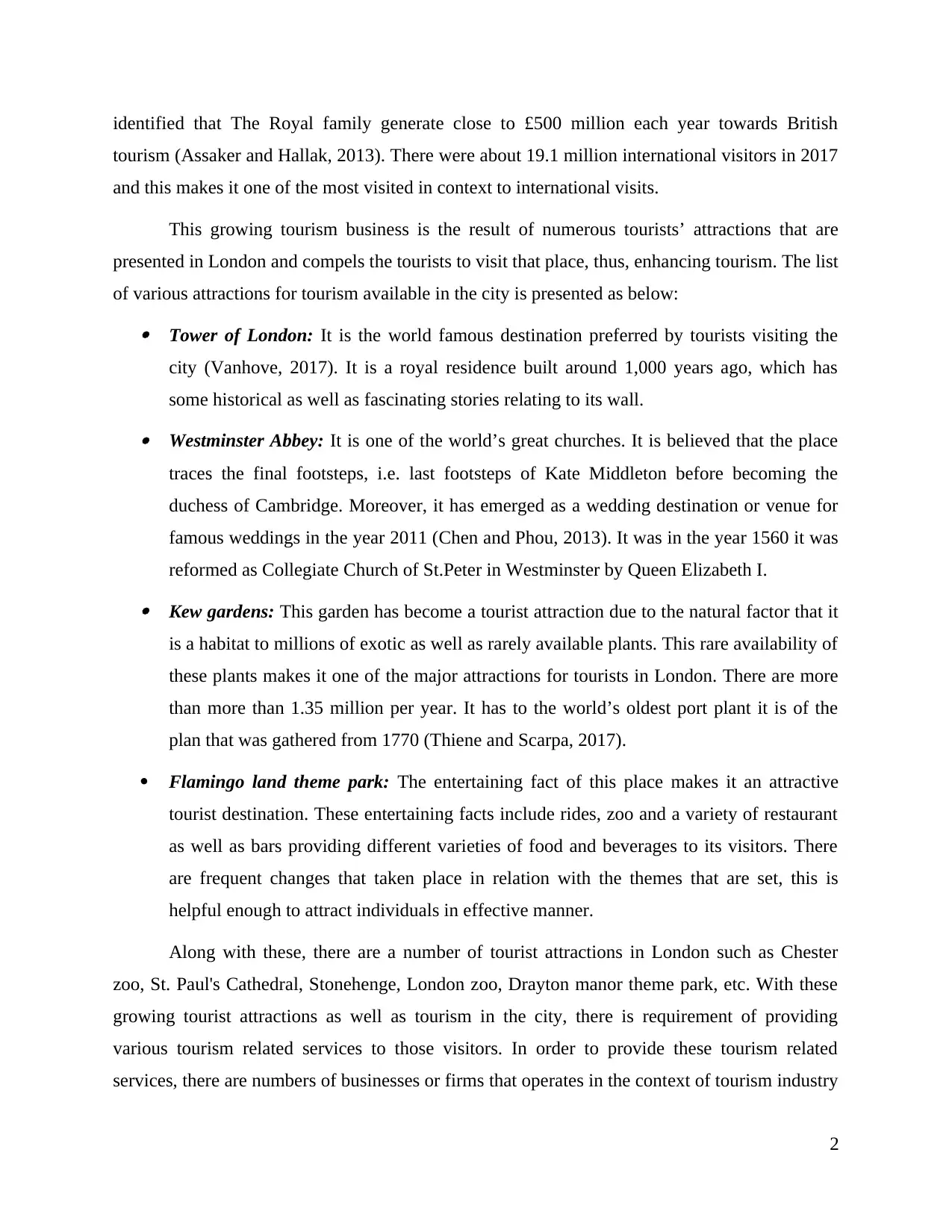
identified that The Royal family generate close to £500 million each year towards British
tourism (Assaker and Hallak, 2013). There were about 19.1 million international visitors in 2017
and this makes it one of the most visited in context to international visits.
This growing tourism business is the result of numerous tourists’ attractions that are
presented in London and compels the tourists to visit that place, thus, enhancing tourism. The list
of various attractions for tourism available in the city is presented as below: Tower of London: It is the world famous destination preferred by tourists visiting the
city (Vanhove, 2017). It is a royal residence built around 1,000 years ago, which has
some historical as well as fascinating stories relating to its wall. Westminster Abbey: It is one of the world’s great churches. It is believed that the place
traces the final footsteps, i.e. last footsteps of Kate Middleton before becoming the
duchess of Cambridge. Moreover, it has emerged as a wedding destination or venue for
famous weddings in the year 2011 (Chen and Phou, 2013). It was in the year 1560 it was
reformed as Collegiate Church of St.Peter in Westminster by Queen Elizabeth I. Kew gardens: This garden has become a tourist attraction due to the natural factor that it
is a habitat to millions of exotic as well as rarely available plants. This rare availability of
these plants makes it one of the major attractions for tourists in London. There are more
than more than 1.35 million per year. It has to the world’s oldest port plant it is of the
plan that was gathered from 1770 (Thiene and Scarpa, 2017).
Flamingo land theme park: The entertaining fact of this place makes it an attractive
tourist destination. These entertaining facts include rides, zoo and a variety of restaurant
as well as bars providing different varieties of food and beverages to its visitors. There
are frequent changes that taken place in relation with the themes that are set, this is
helpful enough to attract individuals in effective manner.
Along with these, there are a number of tourist attractions in London such as Chester
zoo, St. Paul's Cathedral, Stonehenge, London zoo, Drayton manor theme park, etc. With these
growing tourist attractions as well as tourism in the city, there is requirement of providing
various tourism related services to those visitors. In order to provide these tourism related
services, there are numbers of businesses or firms that operates in the context of tourism industry
2
tourism (Assaker and Hallak, 2013). There were about 19.1 million international visitors in 2017
and this makes it one of the most visited in context to international visits.
This growing tourism business is the result of numerous tourists’ attractions that are
presented in London and compels the tourists to visit that place, thus, enhancing tourism. The list
of various attractions for tourism available in the city is presented as below: Tower of London: It is the world famous destination preferred by tourists visiting the
city (Vanhove, 2017). It is a royal residence built around 1,000 years ago, which has
some historical as well as fascinating stories relating to its wall. Westminster Abbey: It is one of the world’s great churches. It is believed that the place
traces the final footsteps, i.e. last footsteps of Kate Middleton before becoming the
duchess of Cambridge. Moreover, it has emerged as a wedding destination or venue for
famous weddings in the year 2011 (Chen and Phou, 2013). It was in the year 1560 it was
reformed as Collegiate Church of St.Peter in Westminster by Queen Elizabeth I. Kew gardens: This garden has become a tourist attraction due to the natural factor that it
is a habitat to millions of exotic as well as rarely available plants. This rare availability of
these plants makes it one of the major attractions for tourists in London. There are more
than more than 1.35 million per year. It has to the world’s oldest port plant it is of the
plan that was gathered from 1770 (Thiene and Scarpa, 2017).
Flamingo land theme park: The entertaining fact of this place makes it an attractive
tourist destination. These entertaining facts include rides, zoo and a variety of restaurant
as well as bars providing different varieties of food and beverages to its visitors. There
are frequent changes that taken place in relation with the themes that are set, this is
helpful enough to attract individuals in effective manner.
Along with these, there are a number of tourist attractions in London such as Chester
zoo, St. Paul's Cathedral, Stonehenge, London zoo, Drayton manor theme park, etc. With these
growing tourist attractions as well as tourism in the city, there is requirement of providing
various tourism related services to those visitors. In order to provide these tourism related
services, there are numbers of businesses or firms that operates in the context of tourism industry
2
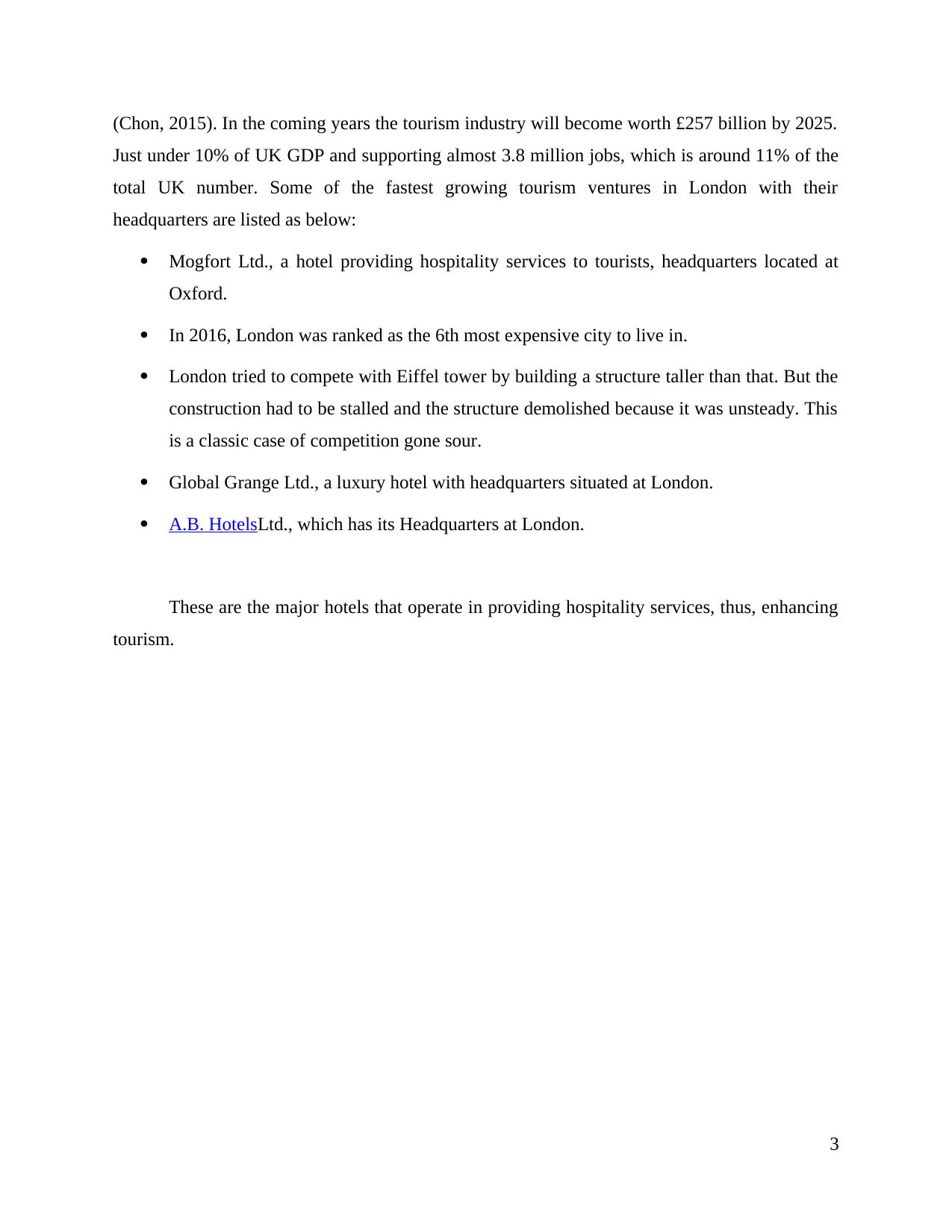
(Chon, 2015). In the coming years the tourism industry will become worth £257 billion by 2025.
Just under 10% of UK GDP and supporting almost 3.8 million jobs, which is around 11% of the
total UK number. Some of the fastest growing tourism ventures in London with their
headquarters are listed as below:
Mogfort Ltd., a hotel providing hospitality services to tourists, headquarters located at
Oxford.
In 2016, London was ranked as the 6th most expensive city to live in.
London tried to compete with Eiffel tower by building a structure taller than that. But the
construction had to be stalled and the structure demolished because it was unsteady. This
is a classic case of competition gone sour.
Global Grange Ltd., a luxury hotel with headquarters situated at London.
A.B. HotelsLtd., which has its Headquarters at London.
These are the major hotels that operate in providing hospitality services, thus, enhancing
tourism.
3
Just under 10% of UK GDP and supporting almost 3.8 million jobs, which is around 11% of the
total UK number. Some of the fastest growing tourism ventures in London with their
headquarters are listed as below:
Mogfort Ltd., a hotel providing hospitality services to tourists, headquarters located at
Oxford.
In 2016, London was ranked as the 6th most expensive city to live in.
London tried to compete with Eiffel tower by building a structure taller than that. But the
construction had to be stalled and the structure demolished because it was unsteady. This
is a classic case of competition gone sour.
Global Grange Ltd., a luxury hotel with headquarters situated at London.
A.B. HotelsLtd., which has its Headquarters at London.
These are the major hotels that operate in providing hospitality services, thus, enhancing
tourism.
3
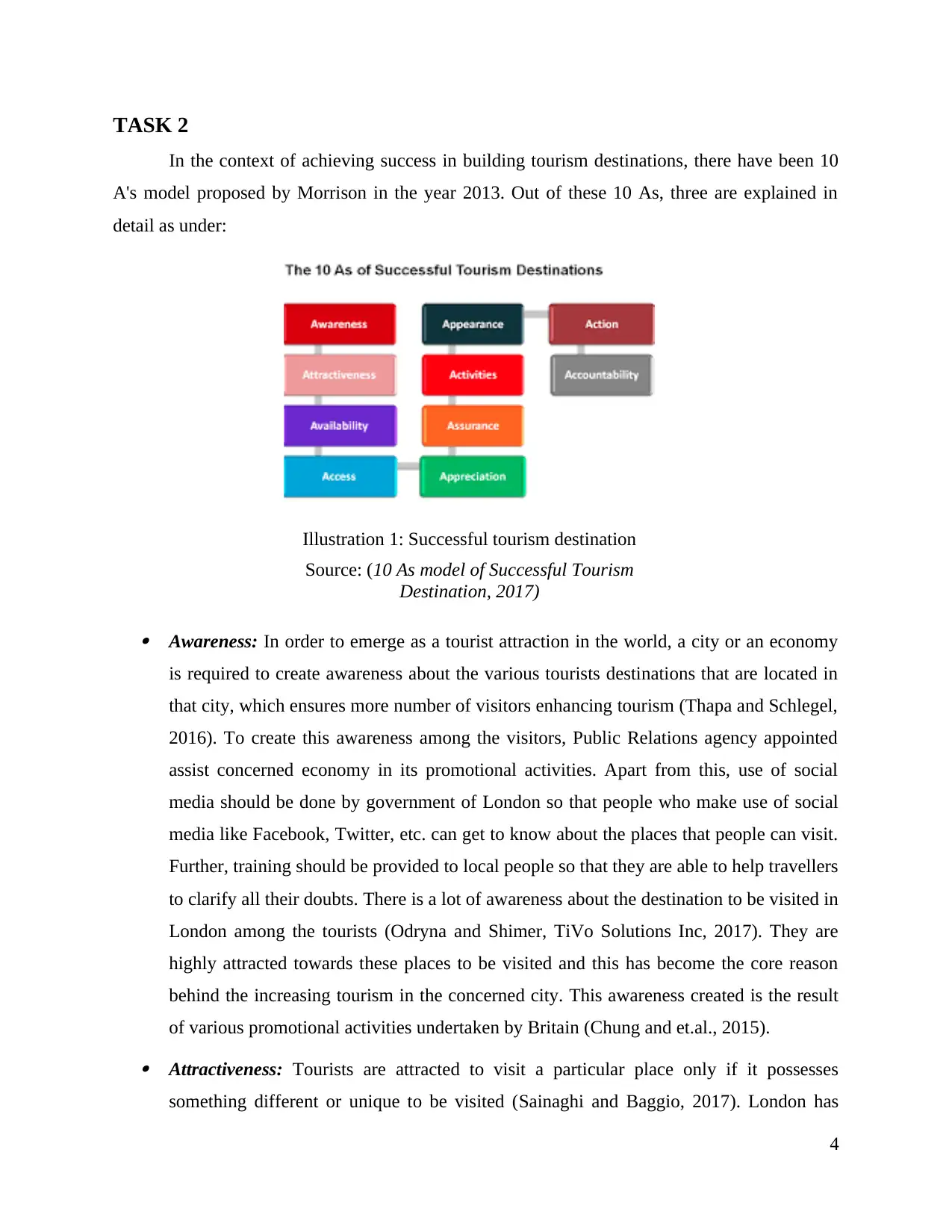
TASK 2
In the context of achieving success in building tourism destinations, there have been 10
A's model proposed by Morrison in the year 2013. Out of these 10 As, three are explained in
detail as under:
Awareness: In order to emerge as a tourist attraction in the world, a city or an economy
is required to create awareness about the various tourists destinations that are located in
that city, which ensures more number of visitors enhancing tourism (Thapa and Schlegel,
2016). To create this awareness among the visitors, Public Relations agency appointed
assist concerned economy in its promotional activities. Apart from this, use of social
media should be done by government of London so that people who make use of social
media like Facebook, Twitter, etc. can get to know about the places that people can visit.
Further, training should be provided to local people so that they are able to help travellers
to clarify all their doubts. There is a lot of awareness about the destination to be visited in
London among the tourists (Odryna and Shimer, TiVo Solutions Inc, 2017). They are
highly attracted towards these places to be visited and this has become the core reason
behind the increasing tourism in the concerned city. This awareness created is the result
of various promotional activities undertaken by Britain (Chung and et.al., 2015). Attractiveness: Tourists are attracted to visit a particular place only if it possesses
something different or unique to be visited (Sainaghi and Baggio, 2017). London has
4
Illustration 1: Successful tourism destination
Source: (10 As model of Successful Tourism
Destination, 2017)
In the context of achieving success in building tourism destinations, there have been 10
A's model proposed by Morrison in the year 2013. Out of these 10 As, three are explained in
detail as under:
Awareness: In order to emerge as a tourist attraction in the world, a city or an economy
is required to create awareness about the various tourists destinations that are located in
that city, which ensures more number of visitors enhancing tourism (Thapa and Schlegel,
2016). To create this awareness among the visitors, Public Relations agency appointed
assist concerned economy in its promotional activities. Apart from this, use of social
media should be done by government of London so that people who make use of social
media like Facebook, Twitter, etc. can get to know about the places that people can visit.
Further, training should be provided to local people so that they are able to help travellers
to clarify all their doubts. There is a lot of awareness about the destination to be visited in
London among the tourists (Odryna and Shimer, TiVo Solutions Inc, 2017). They are
highly attracted towards these places to be visited and this has become the core reason
behind the increasing tourism in the concerned city. This awareness created is the result
of various promotional activities undertaken by Britain (Chung and et.al., 2015). Attractiveness: Tourists are attracted to visit a particular place only if it possesses
something different or unique to be visited (Sainaghi and Baggio, 2017). London has
4
Illustration 1: Successful tourism destination
Source: (10 As model of Successful Tourism
Destination, 2017)
Secure Best Marks with AI Grader
Need help grading? Try our AI Grader for instant feedback on your assignments.
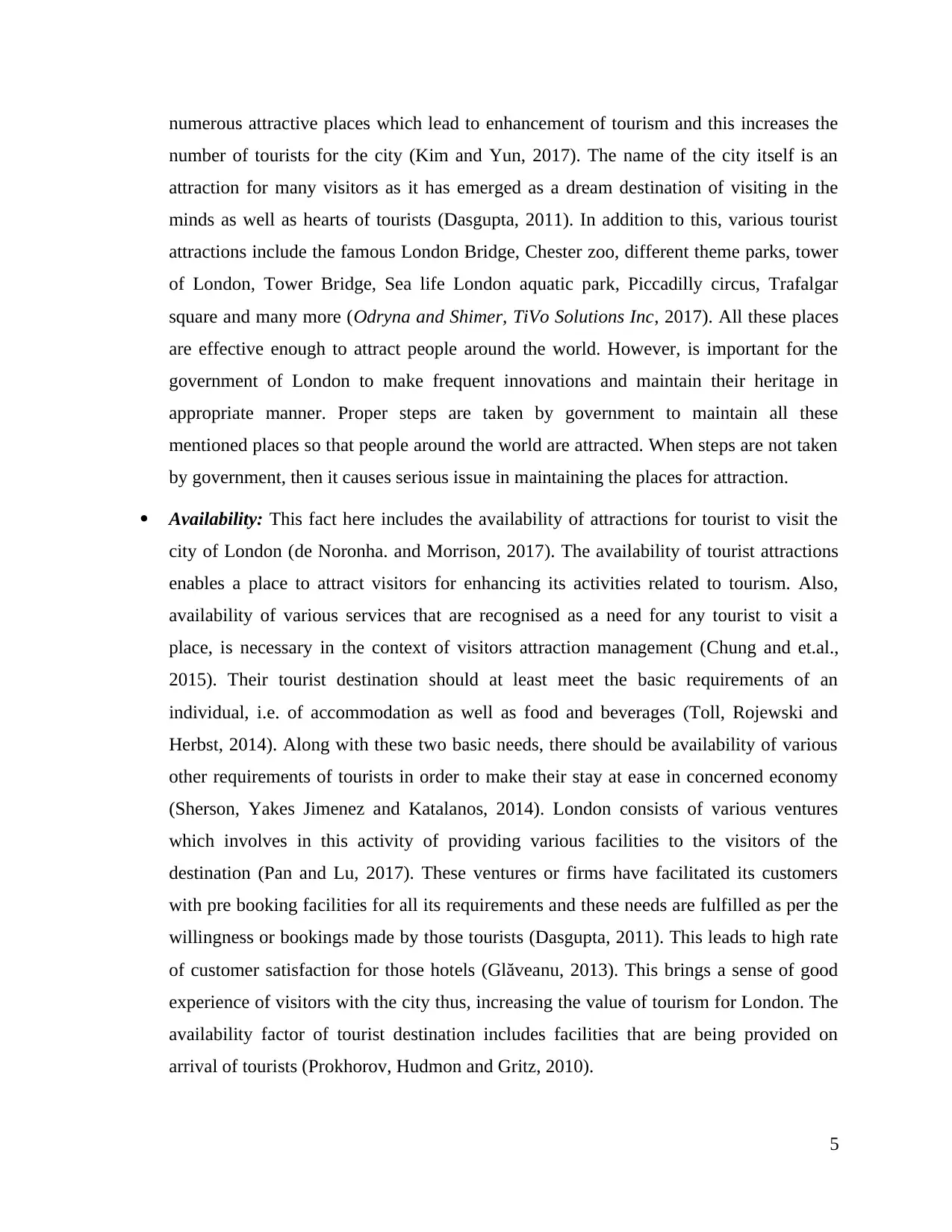
numerous attractive places which lead to enhancement of tourism and this increases the
number of tourists for the city (Kim and Yun, 2017). The name of the city itself is an
attraction for many visitors as it has emerged as a dream destination of visiting in the
minds as well as hearts of tourists (Dasgupta, 2011). In addition to this, various tourist
attractions include the famous London Bridge, Chester zoo, different theme parks, tower
of London, Tower Bridge, Sea life London aquatic park, Piccadilly circus, Trafalgar
square and many more (Odryna and Shimer, TiVo Solutions Inc, 2017). All these places
are effective enough to attract people around the world. However, is important for the
government of London to make frequent innovations and maintain their heritage in
appropriate manner. Proper steps are taken by government to maintain all these
mentioned places so that people around the world are attracted. When steps are not taken
by government, then it causes serious issue in maintaining the places for attraction.
Availability: This fact here includes the availability of attractions for tourist to visit the
city of London (de Noronha. and Morrison, 2017). The availability of tourist attractions
enables a place to attract visitors for enhancing its activities related to tourism. Also,
availability of various services that are recognised as a need for any tourist to visit a
place, is necessary in the context of visitors attraction management (Chung and et.al.,
2015). Their tourist destination should at least meet the basic requirements of an
individual, i.e. of accommodation as well as food and beverages (Toll, Rojewski and
Herbst, 2014). Along with these two basic needs, there should be availability of various
other requirements of tourists in order to make their stay at ease in concerned economy
(Sherson, Yakes Jimenez and Katalanos, 2014). London consists of various ventures
which involves in this activity of providing various facilities to the visitors of the
destination (Pan and Lu, 2017). These ventures or firms have facilitated its customers
with pre booking facilities for all its requirements and these needs are fulfilled as per the
willingness or bookings made by those tourists (Dasgupta, 2011). This leads to high rate
of customer satisfaction for those hotels (Glăveanu, 2013). This brings a sense of good
experience of visitors with the city thus, increasing the value of tourism for London. The
availability factor of tourist destination includes facilities that are being provided on
arrival of tourists (Prokhorov, Hudmon and Gritz, 2010).
5
number of tourists for the city (Kim and Yun, 2017). The name of the city itself is an
attraction for many visitors as it has emerged as a dream destination of visiting in the
minds as well as hearts of tourists (Dasgupta, 2011). In addition to this, various tourist
attractions include the famous London Bridge, Chester zoo, different theme parks, tower
of London, Tower Bridge, Sea life London aquatic park, Piccadilly circus, Trafalgar
square and many more (Odryna and Shimer, TiVo Solutions Inc, 2017). All these places
are effective enough to attract people around the world. However, is important for the
government of London to make frequent innovations and maintain their heritage in
appropriate manner. Proper steps are taken by government to maintain all these
mentioned places so that people around the world are attracted. When steps are not taken
by government, then it causes serious issue in maintaining the places for attraction.
Availability: This fact here includes the availability of attractions for tourist to visit the
city of London (de Noronha. and Morrison, 2017). The availability of tourist attractions
enables a place to attract visitors for enhancing its activities related to tourism. Also,
availability of various services that are recognised as a need for any tourist to visit a
place, is necessary in the context of visitors attraction management (Chung and et.al.,
2015). Their tourist destination should at least meet the basic requirements of an
individual, i.e. of accommodation as well as food and beverages (Toll, Rojewski and
Herbst, 2014). Along with these two basic needs, there should be availability of various
other requirements of tourists in order to make their stay at ease in concerned economy
(Sherson, Yakes Jimenez and Katalanos, 2014). London consists of various ventures
which involves in this activity of providing various facilities to the visitors of the
destination (Pan and Lu, 2017). These ventures or firms have facilitated its customers
with pre booking facilities for all its requirements and these needs are fulfilled as per the
willingness or bookings made by those tourists (Dasgupta, 2011). This leads to high rate
of customer satisfaction for those hotels (Glăveanu, 2013). This brings a sense of good
experience of visitors with the city thus, increasing the value of tourism for London. The
availability factor of tourist destination includes facilities that are being provided on
arrival of tourists (Prokhorov, Hudmon and Gritz, 2010).
5
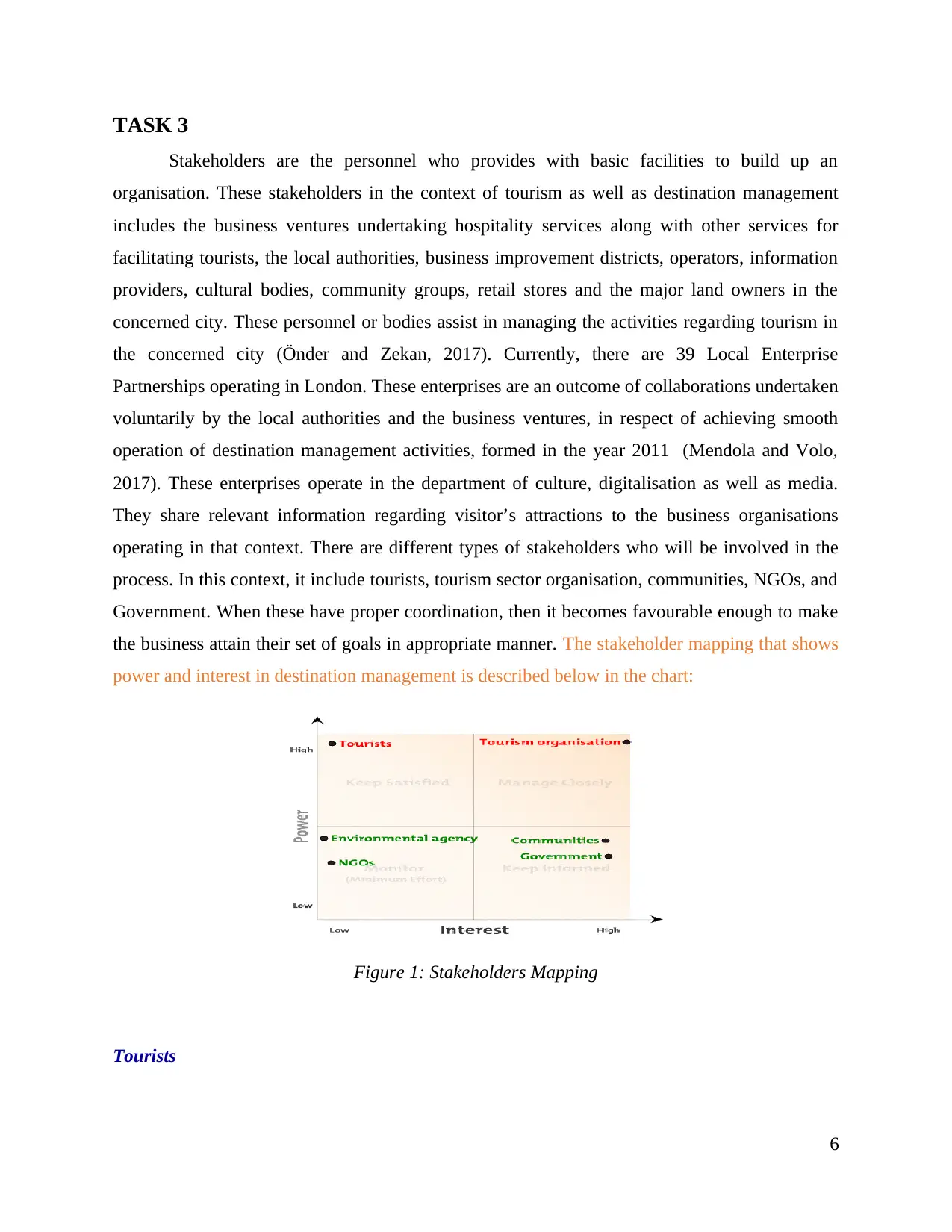
TASK 3
Stakeholders are the personnel who provides with basic facilities to build up an
organisation. These stakeholders in the context of tourism as well as destination management
includes the business ventures undertaking hospitality services along with other services for
facilitating tourists, the local authorities, business improvement districts, operators, information
providers, cultural bodies, community groups, retail stores and the major land owners in the
concerned city. These personnel or bodies assist in managing the activities regarding tourism in
the concerned city (Önder and Zekan, 2017). Currently, there are 39 Local Enterprise
Partnerships operating in London. These enterprises are an outcome of collaborations undertaken
voluntarily by the local authorities and the business ventures, in respect of achieving smooth
operation of destination management activities, formed in the year 2011 (Mendola and Volo,
2017). These enterprises operate in the department of culture, digitalisation as well as media.
They share relevant information regarding visitor’s attractions to the business organisations
operating in that context. There are different types of stakeholders who will be involved in the
process. In this context, it include tourists, tourism sector organisation, communities, NGOs, and
Government. When these have proper coordination, then it becomes favourable enough to make
the business attain their set of goals in appropriate manner. The stakeholder mapping that shows
power and interest in destination management is described below in the chart:
Figure 1: Stakeholders Mapping
Tourists
6
Stakeholders are the personnel who provides with basic facilities to build up an
organisation. These stakeholders in the context of tourism as well as destination management
includes the business ventures undertaking hospitality services along with other services for
facilitating tourists, the local authorities, business improvement districts, operators, information
providers, cultural bodies, community groups, retail stores and the major land owners in the
concerned city. These personnel or bodies assist in managing the activities regarding tourism in
the concerned city (Önder and Zekan, 2017). Currently, there are 39 Local Enterprise
Partnerships operating in London. These enterprises are an outcome of collaborations undertaken
voluntarily by the local authorities and the business ventures, in respect of achieving smooth
operation of destination management activities, formed in the year 2011 (Mendola and Volo,
2017). These enterprises operate in the department of culture, digitalisation as well as media.
They share relevant information regarding visitor’s attractions to the business organisations
operating in that context. There are different types of stakeholders who will be involved in the
process. In this context, it include tourists, tourism sector organisation, communities, NGOs, and
Government. When these have proper coordination, then it becomes favourable enough to make
the business attain their set of goals in appropriate manner. The stakeholder mapping that shows
power and interest in destination management is described below in the chart:
Figure 1: Stakeholders Mapping
Tourists
6
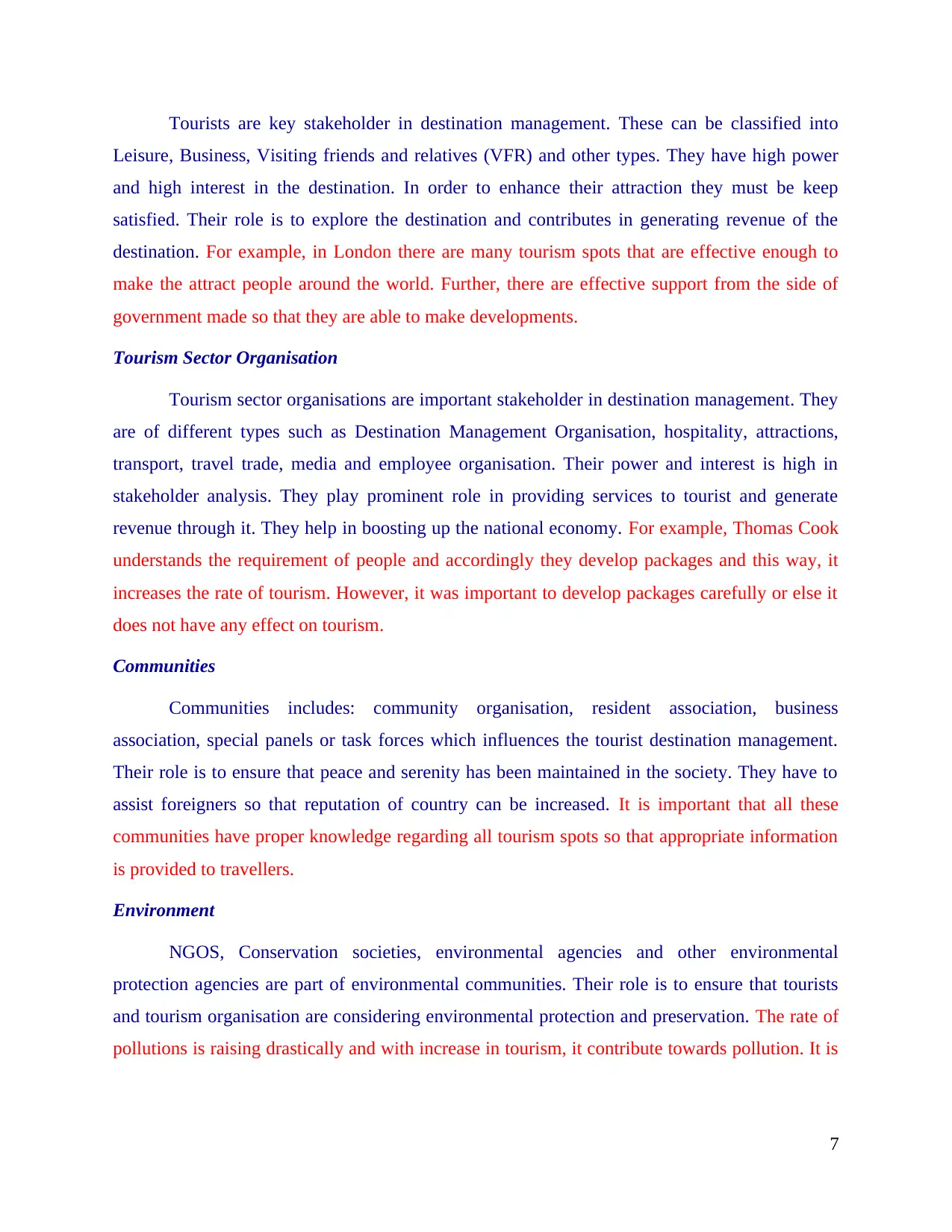
Tourists are key stakeholder in destination management. These can be classified into
Leisure, Business, Visiting friends and relatives (VFR) and other types. They have high power
and high interest in the destination. In order to enhance their attraction they must be keep
satisfied. Their role is to explore the destination and contributes in generating revenue of the
destination. For example, in London there are many tourism spots that are effective enough to
make the attract people around the world. Further, there are effective support from the side of
government made so that they are able to make developments.
Tourism Sector Organisation
Tourism sector organisations are important stakeholder in destination management. They
are of different types such as Destination Management Organisation, hospitality, attractions,
transport, travel trade, media and employee organisation. Their power and interest is high in
stakeholder analysis. They play prominent role in providing services to tourist and generate
revenue through it. They help in boosting up the national economy. For example, Thomas Cook
understands the requirement of people and accordingly they develop packages and this way, it
increases the rate of tourism. However, it was important to develop packages carefully or else it
does not have any effect on tourism.
Communities
Communities includes: community organisation, resident association, business
association, special panels or task forces which influences the tourist destination management.
Their role is to ensure that peace and serenity has been maintained in the society. They have to
assist foreigners so that reputation of country can be increased. It is important that all these
communities have proper knowledge regarding all tourism spots so that appropriate information
is provided to travellers.
Environment
NGOS, Conservation societies, environmental agencies and other environmental
protection agencies are part of environmental communities. Their role is to ensure that tourists
and tourism organisation are considering environmental protection and preservation. The rate of
pollutions is raising drastically and with increase in tourism, it contribute towards pollution. It is
7
Leisure, Business, Visiting friends and relatives (VFR) and other types. They have high power
and high interest in the destination. In order to enhance their attraction they must be keep
satisfied. Their role is to explore the destination and contributes in generating revenue of the
destination. For example, in London there are many tourism spots that are effective enough to
make the attract people around the world. Further, there are effective support from the side of
government made so that they are able to make developments.
Tourism Sector Organisation
Tourism sector organisations are important stakeholder in destination management. They
are of different types such as Destination Management Organisation, hospitality, attractions,
transport, travel trade, media and employee organisation. Their power and interest is high in
stakeholder analysis. They play prominent role in providing services to tourist and generate
revenue through it. They help in boosting up the national economy. For example, Thomas Cook
understands the requirement of people and accordingly they develop packages and this way, it
increases the rate of tourism. However, it was important to develop packages carefully or else it
does not have any effect on tourism.
Communities
Communities includes: community organisation, resident association, business
association, special panels or task forces which influences the tourist destination management.
Their role is to ensure that peace and serenity has been maintained in the society. They have to
assist foreigners so that reputation of country can be increased. It is important that all these
communities have proper knowledge regarding all tourism spots so that appropriate information
is provided to travellers.
Environment
NGOS, Conservation societies, environmental agencies and other environmental
protection agencies are part of environmental communities. Their role is to ensure that tourists
and tourism organisation are considering environmental protection and preservation. The rate of
pollutions is raising drastically and with increase in tourism, it contribute towards pollution. It is
7
Paraphrase This Document
Need a fresh take? Get an instant paraphrase of this document with our AI Paraphraser
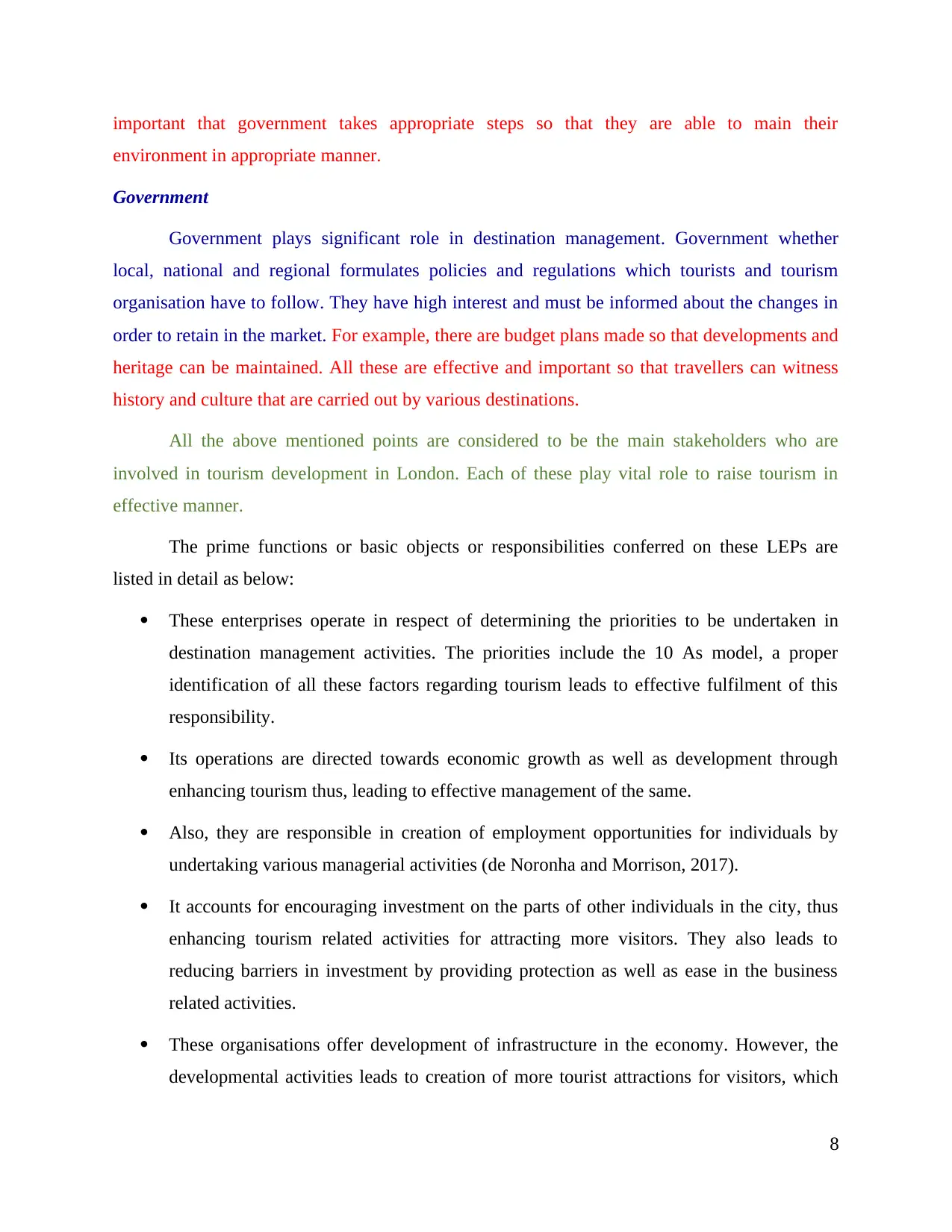
important that government takes appropriate steps so that they are able to main their
environment in appropriate manner.
Government
Government plays significant role in destination management. Government whether
local, national and regional formulates policies and regulations which tourists and tourism
organisation have to follow. They have high interest and must be informed about the changes in
order to retain in the market. For example, there are budget plans made so that developments and
heritage can be maintained. All these are effective and important so that travellers can witness
history and culture that are carried out by various destinations.
All the above mentioned points are considered to be the main stakeholders who are
involved in tourism development in London. Each of these play vital role to raise tourism in
effective manner.
The prime functions or basic objects or responsibilities conferred on these LEPs are
listed in detail as below:
These enterprises operate in respect of determining the priorities to be undertaken in
destination management activities. The priorities include the 10 As model, a proper
identification of all these factors regarding tourism leads to effective fulfilment of this
responsibility.
Its operations are directed towards economic growth as well as development through
enhancing tourism thus, leading to effective management of the same.
Also, they are responsible in creation of employment opportunities for individuals by
undertaking various managerial activities (de Noronha and Morrison, 2017).
It accounts for encouraging investment on the parts of other individuals in the city, thus
enhancing tourism related activities for attracting more visitors. They also leads to
reducing barriers in investment by providing protection as well as ease in the business
related activities.
These organisations offer development of infrastructure in the economy. However, the
developmental activities leads to creation of more tourist attractions for visitors, which
8
environment in appropriate manner.
Government
Government plays significant role in destination management. Government whether
local, national and regional formulates policies and regulations which tourists and tourism
organisation have to follow. They have high interest and must be informed about the changes in
order to retain in the market. For example, there are budget plans made so that developments and
heritage can be maintained. All these are effective and important so that travellers can witness
history and culture that are carried out by various destinations.
All the above mentioned points are considered to be the main stakeholders who are
involved in tourism development in London. Each of these play vital role to raise tourism in
effective manner.
The prime functions or basic objects or responsibilities conferred on these LEPs are
listed in detail as below:
These enterprises operate in respect of determining the priorities to be undertaken in
destination management activities. The priorities include the 10 As model, a proper
identification of all these factors regarding tourism leads to effective fulfilment of this
responsibility.
Its operations are directed towards economic growth as well as development through
enhancing tourism thus, leading to effective management of the same.
Also, they are responsible in creation of employment opportunities for individuals by
undertaking various managerial activities (de Noronha and Morrison, 2017).
It accounts for encouraging investment on the parts of other individuals in the city, thus
enhancing tourism related activities for attracting more visitors. They also leads to
reducing barriers in investment by providing protection as well as ease in the business
related activities.
These organisations offer development of infrastructure in the economy. However, the
developmental activities leads to creation of more tourist attractions for visitors, which
8
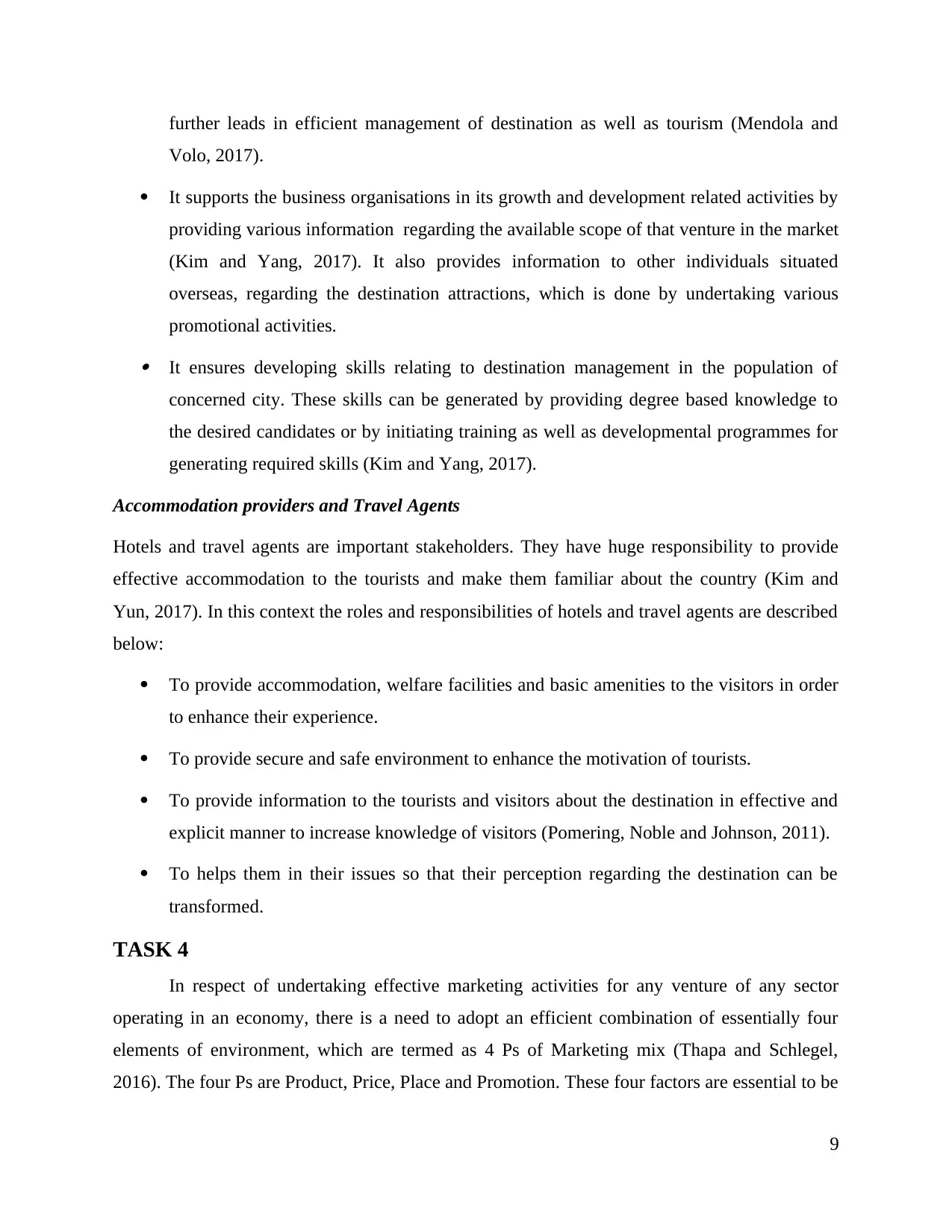
further leads in efficient management of destination as well as tourism (Mendola and
Volo, 2017).
It supports the business organisations in its growth and development related activities by
providing various information regarding the available scope of that venture in the market
(Kim and Yang, 2017). It also provides information to other individuals situated
overseas, regarding the destination attractions, which is done by undertaking various
promotional activities. It ensures developing skills relating to destination management in the population of
concerned city. These skills can be generated by providing degree based knowledge to
the desired candidates or by initiating training as well as developmental programmes for
generating required skills (Kim and Yang, 2017).
Accommodation providers and Travel Agents
Hotels and travel agents are important stakeholders. They have huge responsibility to provide
effective accommodation to the tourists and make them familiar about the country (Kim and
Yun, 2017). In this context the roles and responsibilities of hotels and travel agents are described
below:
To provide accommodation, welfare facilities and basic amenities to the visitors in order
to enhance their experience.
To provide secure and safe environment to enhance the motivation of tourists.
To provide information to the tourists and visitors about the destination in effective and
explicit manner to increase knowledge of visitors (Pomering, Noble and Johnson, 2011).
To helps them in their issues so that their perception regarding the destination can be
transformed.
TASK 4
In respect of undertaking effective marketing activities for any venture of any sector
operating in an economy, there is a need to adopt an efficient combination of essentially four
elements of environment, which are termed as 4 Ps of Marketing mix (Thapa and Schlegel,
2016). The four Ps are Product, Price, Place and Promotion. These four factors are essential to be
9
Volo, 2017).
It supports the business organisations in its growth and development related activities by
providing various information regarding the available scope of that venture in the market
(Kim and Yang, 2017). It also provides information to other individuals situated
overseas, regarding the destination attractions, which is done by undertaking various
promotional activities. It ensures developing skills relating to destination management in the population of
concerned city. These skills can be generated by providing degree based knowledge to
the desired candidates or by initiating training as well as developmental programmes for
generating required skills (Kim and Yang, 2017).
Accommodation providers and Travel Agents
Hotels and travel agents are important stakeholders. They have huge responsibility to provide
effective accommodation to the tourists and make them familiar about the country (Kim and
Yun, 2017). In this context the roles and responsibilities of hotels and travel agents are described
below:
To provide accommodation, welfare facilities and basic amenities to the visitors in order
to enhance their experience.
To provide secure and safe environment to enhance the motivation of tourists.
To provide information to the tourists and visitors about the destination in effective and
explicit manner to increase knowledge of visitors (Pomering, Noble and Johnson, 2011).
To helps them in their issues so that their perception regarding the destination can be
transformed.
TASK 4
In respect of undertaking effective marketing activities for any venture of any sector
operating in an economy, there is a need to adopt an efficient combination of essentially four
elements of environment, which are termed as 4 Ps of Marketing mix (Thapa and Schlegel,
2016). The four Ps are Product, Price, Place and Promotion. These four factors are essential to be
9
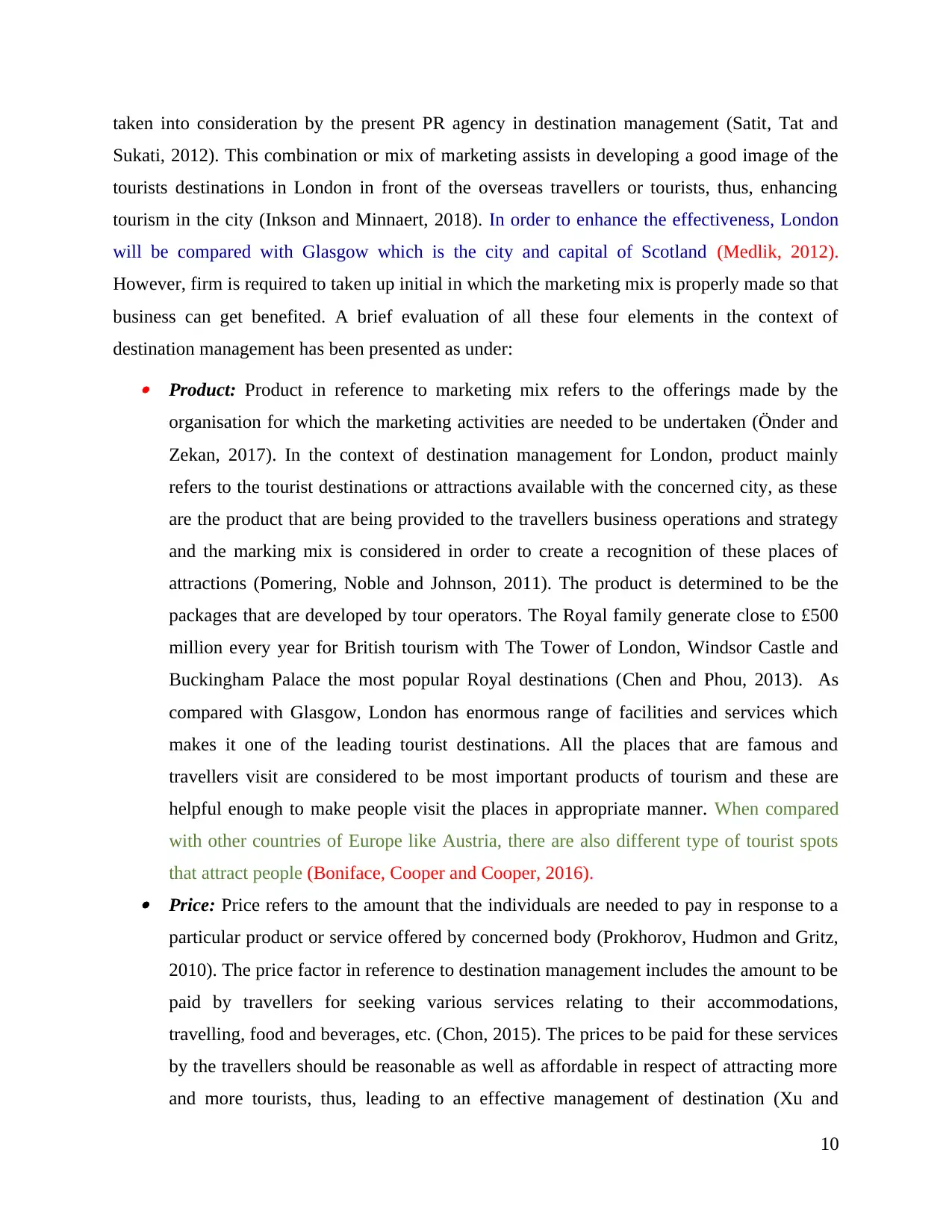
taken into consideration by the present PR agency in destination management (Satit, Tat and
Sukati, 2012). This combination or mix of marketing assists in developing a good image of the
tourists destinations in London in front of the overseas travellers or tourists, thus, enhancing
tourism in the city (Inkson and Minnaert, 2018). In order to enhance the effectiveness, London
will be compared with Glasgow which is the city and capital of Scotland (Medlik, 2012).
However, firm is required to taken up initial in which the marketing mix is properly made so that
business can get benefited. A brief evaluation of all these four elements in the context of
destination management has been presented as under: Product: Product in reference to marketing mix refers to the offerings made by the
organisation for which the marketing activities are needed to be undertaken (Önder and
Zekan, 2017). In the context of destination management for London, product mainly
refers to the tourist destinations or attractions available with the concerned city, as these
are the product that are being provided to the travellers business operations and strategy
and the marking mix is considered in order to create a recognition of these places of
attractions (Pomering, Noble and Johnson, 2011). The product is determined to be the
packages that are developed by tour operators. The Royal family generate close to £500
million every year for British tourism with The Tower of London, Windsor Castle and
Buckingham Palace the most popular Royal destinations (Chen and Phou, 2013). As
compared with Glasgow, London has enormous range of facilities and services which
makes it one of the leading tourist destinations. All the places that are famous and
travellers visit are considered to be most important products of tourism and these are
helpful enough to make people visit the places in appropriate manner. When compared
with other countries of Europe like Austria, there are also different type of tourist spots
that attract people (Boniface, Cooper and Cooper, 2016). Price: Price refers to the amount that the individuals are needed to pay in response to a
particular product or service offered by concerned body (Prokhorov, Hudmon and Gritz,
2010). The price factor in reference to destination management includes the amount to be
paid by travellers for seeking various services relating to their accommodations,
travelling, food and beverages, etc. (Chon, 2015). The prices to be paid for these services
by the travellers should be reasonable as well as affordable in respect of attracting more
and more tourists, thus, leading to an effective management of destination (Xu and
10
Sukati, 2012). This combination or mix of marketing assists in developing a good image of the
tourists destinations in London in front of the overseas travellers or tourists, thus, enhancing
tourism in the city (Inkson and Minnaert, 2018). In order to enhance the effectiveness, London
will be compared with Glasgow which is the city and capital of Scotland (Medlik, 2012).
However, firm is required to taken up initial in which the marketing mix is properly made so that
business can get benefited. A brief evaluation of all these four elements in the context of
destination management has been presented as under: Product: Product in reference to marketing mix refers to the offerings made by the
organisation for which the marketing activities are needed to be undertaken (Önder and
Zekan, 2017). In the context of destination management for London, product mainly
refers to the tourist destinations or attractions available with the concerned city, as these
are the product that are being provided to the travellers business operations and strategy
and the marking mix is considered in order to create a recognition of these places of
attractions (Pomering, Noble and Johnson, 2011). The product is determined to be the
packages that are developed by tour operators. The Royal family generate close to £500
million every year for British tourism with The Tower of London, Windsor Castle and
Buckingham Palace the most popular Royal destinations (Chen and Phou, 2013). As
compared with Glasgow, London has enormous range of facilities and services which
makes it one of the leading tourist destinations. All the places that are famous and
travellers visit are considered to be most important products of tourism and these are
helpful enough to make people visit the places in appropriate manner. When compared
with other countries of Europe like Austria, there are also different type of tourist spots
that attract people (Boniface, Cooper and Cooper, 2016). Price: Price refers to the amount that the individuals are needed to pay in response to a
particular product or service offered by concerned body (Prokhorov, Hudmon and Gritz,
2010). The price factor in reference to destination management includes the amount to be
paid by travellers for seeking various services relating to their accommodations,
travelling, food and beverages, etc. (Chon, 2015). The prices to be paid for these services
by the travellers should be reasonable as well as affordable in respect of attracting more
and more tourists, thus, leading to an effective management of destination (Xu and
10
Secure Best Marks with AI Grader
Need help grading? Try our AI Grader for instant feedback on your assignments.
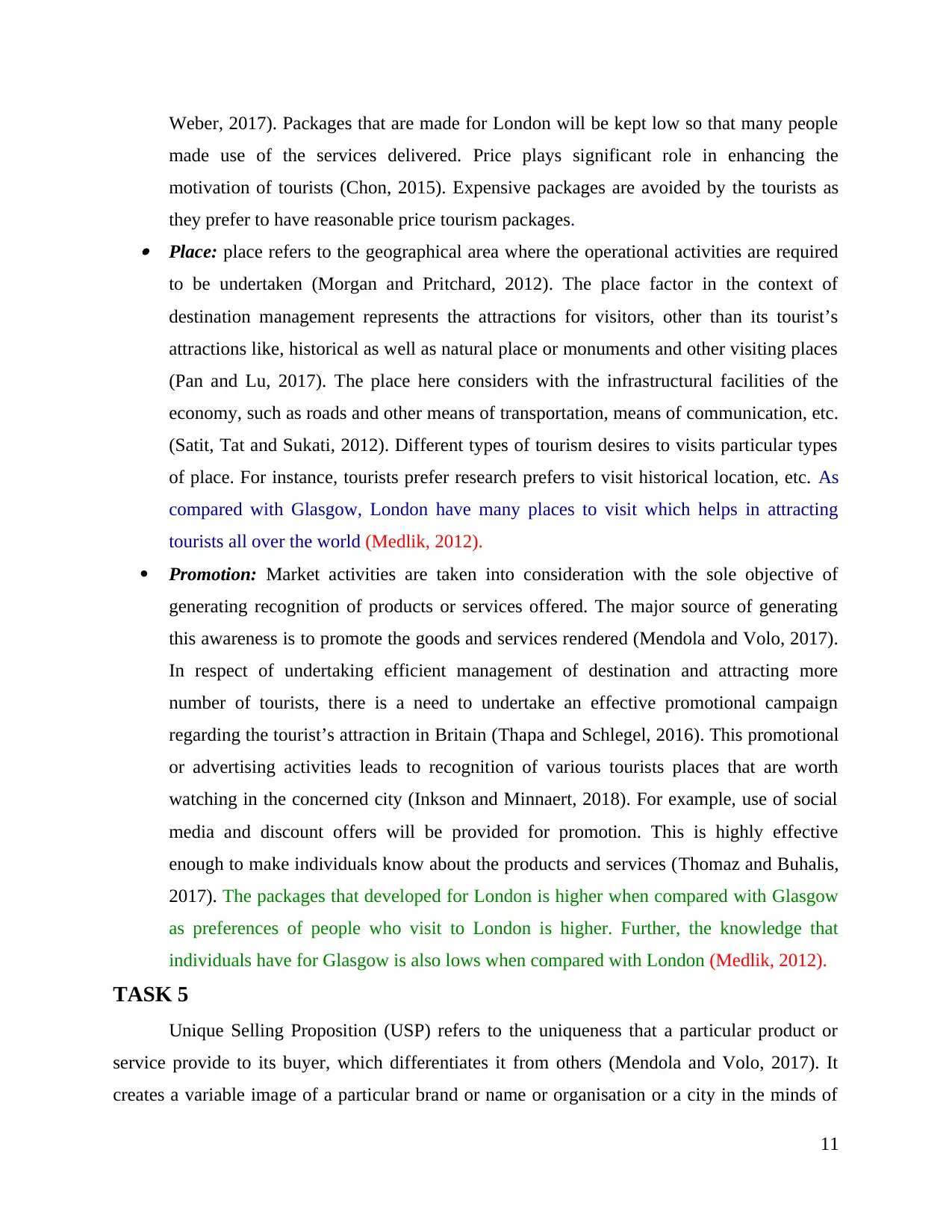
Weber, 2017). Packages that are made for London will be kept low so that many people
made use of the services delivered. Price plays significant role in enhancing the
motivation of tourists (Chon, 2015). Expensive packages are avoided by the tourists as
they prefer to have reasonable price tourism packages. Place: place refers to the geographical area where the operational activities are required
to be undertaken (Morgan and Pritchard, 2012). The place factor in the context of
destination management represents the attractions for visitors, other than its tourist’s
attractions like, historical as well as natural place or monuments and other visiting places
(Pan and Lu, 2017). The place here considers with the infrastructural facilities of the
economy, such as roads and other means of transportation, means of communication, etc.
(Satit, Tat and Sukati, 2012). Different types of tourism desires to visits particular types
of place. For instance, tourists prefer research prefers to visit historical location, etc. As
compared with Glasgow, London have many places to visit which helps in attracting
tourists all over the world (Medlik, 2012).
Promotion: Market activities are taken into consideration with the sole objective of
generating recognition of products or services offered. The major source of generating
this awareness is to promote the goods and services rendered (Mendola and Volo, 2017).
In respect of undertaking efficient management of destination and attracting more
number of tourists, there is a need to undertake an effective promotional campaign
regarding the tourist’s attraction in Britain (Thapa and Schlegel, 2016). This promotional
or advertising activities leads to recognition of various tourists places that are worth
watching in the concerned city (Inkson and Minnaert, 2018). For example, use of social
media and discount offers will be provided for promotion. This is highly effective
enough to make individuals know about the products and services (Thomaz and Buhalis,
2017). The packages that developed for London is higher when compared with Glasgow
as preferences of people who visit to London is higher. Further, the knowledge that
individuals have for Glasgow is also lows when compared with London (Medlik, 2012).
TASK 5
Unique Selling Proposition (USP) refers to the uniqueness that a particular product or
service provide to its buyer, which differentiates it from others (Mendola and Volo, 2017). It
creates a variable image of a particular brand or name or organisation or a city in the minds of
11
made use of the services delivered. Price plays significant role in enhancing the
motivation of tourists (Chon, 2015). Expensive packages are avoided by the tourists as
they prefer to have reasonable price tourism packages. Place: place refers to the geographical area where the operational activities are required
to be undertaken (Morgan and Pritchard, 2012). The place factor in the context of
destination management represents the attractions for visitors, other than its tourist’s
attractions like, historical as well as natural place or monuments and other visiting places
(Pan and Lu, 2017). The place here considers with the infrastructural facilities of the
economy, such as roads and other means of transportation, means of communication, etc.
(Satit, Tat and Sukati, 2012). Different types of tourism desires to visits particular types
of place. For instance, tourists prefer research prefers to visit historical location, etc. As
compared with Glasgow, London have many places to visit which helps in attracting
tourists all over the world (Medlik, 2012).
Promotion: Market activities are taken into consideration with the sole objective of
generating recognition of products or services offered. The major source of generating
this awareness is to promote the goods and services rendered (Mendola and Volo, 2017).
In respect of undertaking efficient management of destination and attracting more
number of tourists, there is a need to undertake an effective promotional campaign
regarding the tourist’s attraction in Britain (Thapa and Schlegel, 2016). This promotional
or advertising activities leads to recognition of various tourists places that are worth
watching in the concerned city (Inkson and Minnaert, 2018). For example, use of social
media and discount offers will be provided for promotion. This is highly effective
enough to make individuals know about the products and services (Thomaz and Buhalis,
2017). The packages that developed for London is higher when compared with Glasgow
as preferences of people who visit to London is higher. Further, the knowledge that
individuals have for Glasgow is also lows when compared with London (Medlik, 2012).
TASK 5
Unique Selling Proposition (USP) refers to the uniqueness that a particular product or
service provide to its buyer, which differentiates it from others (Mendola and Volo, 2017). It
creates a variable image of a particular brand or name or organisation or a city in the minds of
11

concerned target audience. Thus, it has become essential for the management of every venture
related activities to recognise its potentiality and apply creativity in developing a USP, thus,
attracting more number of personnel (Sainaghi and Baggio, 2017). In reference to destination
management, USP refers to the uniqueness that London economy provides to its travellers and
differentiating the host city from others. In the recent years, Britain has emerged as one of the
fastest growing as well as attractive destination for the traveller from the overseas counties or
economies. This has led the concerned city to serve a large group of visitors from overseas, also,
the British prefer to home holidaying, i.e. the people of the city spent their vacation in different
parts of their city only, rather than visiting other counties (Inkson and Minnaert, 2018). USP that
will be used for London will be to develop the tour packages price to be low. There are certain
set of aspects that are considered before making any purchase decision and services are delivered
at low price, then it enables to attract customers. Apart from this, the unique selling proposition
of London is sustainable and ECO Tourism. Here the tourism organisations and operators use
sustainable methods and modes to provide tourisms. It enhances the motivation of tourists and
they attract more towards the destination. The benefit of eco-tourism is that it helps the
organisation to sustain and also assist in preserving the environment of London. In this modern
world the rate of pollutions is rising drastically and tourism also contributes towards the same. In
this context, hybrid or electric vehicles should be used so that rate of pollutions can be reduced.
When country develops an image in which they are aiming the rate of pollution, then it enables
to grow in effective manner (Fennell, 2014). There are certain set of expectations that are carried
out by individuals before travelling to any destination. In this context, people prefer to visit a
place that is rich in heritage, culture, low risk of live, natural beauty, etc. These are effective
enough to raise tourism in effective manner at London.
All the above visits are possible only when they are able to consider time management
and travelling agency support in order to do so. All these are helpful enough to make sure that all
the desired goals by the cited firm city can be attained (Pham and Dwyer, 2017). Along with
these major attractions, there are also other attractions that lies with the city has become USP for
selling its destinations to travellers, i.e. attracting more number of visitor. For this respect,
government need to provide proper training and development to local people so that they have
appropriate knowledge regarding the heritage and their culture, this will help travellers. Further,
new business ideas should be supported by government so that individuals are able to attract
12
related activities to recognise its potentiality and apply creativity in developing a USP, thus,
attracting more number of personnel (Sainaghi and Baggio, 2017). In reference to destination
management, USP refers to the uniqueness that London economy provides to its travellers and
differentiating the host city from others. In the recent years, Britain has emerged as one of the
fastest growing as well as attractive destination for the traveller from the overseas counties or
economies. This has led the concerned city to serve a large group of visitors from overseas, also,
the British prefer to home holidaying, i.e. the people of the city spent their vacation in different
parts of their city only, rather than visiting other counties (Inkson and Minnaert, 2018). USP that
will be used for London will be to develop the tour packages price to be low. There are certain
set of aspects that are considered before making any purchase decision and services are delivered
at low price, then it enables to attract customers. Apart from this, the unique selling proposition
of London is sustainable and ECO Tourism. Here the tourism organisations and operators use
sustainable methods and modes to provide tourisms. It enhances the motivation of tourists and
they attract more towards the destination. The benefit of eco-tourism is that it helps the
organisation to sustain and also assist in preserving the environment of London. In this modern
world the rate of pollutions is rising drastically and tourism also contributes towards the same. In
this context, hybrid or electric vehicles should be used so that rate of pollutions can be reduced.
When country develops an image in which they are aiming the rate of pollution, then it enables
to grow in effective manner (Fennell, 2014). There are certain set of expectations that are carried
out by individuals before travelling to any destination. In this context, people prefer to visit a
place that is rich in heritage, culture, low risk of live, natural beauty, etc. These are effective
enough to raise tourism in effective manner at London.
All the above visits are possible only when they are able to consider time management
and travelling agency support in order to do so. All these are helpful enough to make sure that all
the desired goals by the cited firm city can be attained (Pham and Dwyer, 2017). Along with
these major attractions, there are also other attractions that lies with the city has become USP for
selling its destinations to travellers, i.e. attracting more number of visitor. For this respect,
government need to provide proper training and development to local people so that they have
appropriate knowledge regarding the heritage and their culture, this will help travellers. Further,
new business ideas should be supported by government so that individuals are able to attract
12

individuals in appropriate manner. Apart from this, there needs to be discount offers provided by
airlines so that rate of visitors increases. To attract the customers towards London, effective tour
packages have been created. For distinct customers who have different needs, the tour packages
are created for them. It is meant for all type of tourisms such as educational, adventurous, etc
(Sherson, Yakes Jimenez and Katalanos, 2014).
TASK 6
Every business organisation or sector operates in an economy with a view to generate
earnings with its venture related activities and the offerings that it provides to its customers.
Similarly, the tourism industry in London operates in order to generate high revenue for the
economy, thus, leading to economic growth as well as developmental activities to be undertaken
in the concerned city (Line and Wang, 2017). In respecting of generating long term profits, thus
benefiting the economy, the following mentioned steps can be adopted or followed in the context
of destination management. Marketing: Marketing or undertaking the promotional activities for the recognition of
tourists attractions available in London, can lead to a large number of visitors for the
concerned city from overseas nations. As more number of customers generates more
amount of revenue, similarly, more number of tourists leads to generation of more
earnings for the mentioned nation. For example use of social media like Facebook and
Instagram should be done. Conduction market research: Frequent research should be carried out so that the
preferred places at London can be identified and the package is developed accordingly.
This will help to attract more people. With time, there are many changes that taken place
in relation with the preferences of people and when these are done, then it increases the
rate of travellers. Social media and community building: This has become the major ways of generating
profits for any venture. The visitors who desire to visit Britain should be available to
them for their advance bookings, in order to avoid any inconvenience on the part of
customers (Mendola and Volo, 2017). These pre booking services provided lead to a high
amount of convenience caused to travellers, thus, putting them at ease in their travelling
activities with the city.
13
airlines so that rate of visitors increases. To attract the customers towards London, effective tour
packages have been created. For distinct customers who have different needs, the tour packages
are created for them. It is meant for all type of tourisms such as educational, adventurous, etc
(Sherson, Yakes Jimenez and Katalanos, 2014).
TASK 6
Every business organisation or sector operates in an economy with a view to generate
earnings with its venture related activities and the offerings that it provides to its customers.
Similarly, the tourism industry in London operates in order to generate high revenue for the
economy, thus, leading to economic growth as well as developmental activities to be undertaken
in the concerned city (Line and Wang, 2017). In respecting of generating long term profits, thus
benefiting the economy, the following mentioned steps can be adopted or followed in the context
of destination management. Marketing: Marketing or undertaking the promotional activities for the recognition of
tourists attractions available in London, can lead to a large number of visitors for the
concerned city from overseas nations. As more number of customers generates more
amount of revenue, similarly, more number of tourists leads to generation of more
earnings for the mentioned nation. For example use of social media like Facebook and
Instagram should be done. Conduction market research: Frequent research should be carried out so that the
preferred places at London can be identified and the package is developed accordingly.
This will help to attract more people. With time, there are many changes that taken place
in relation with the preferences of people and when these are done, then it increases the
rate of travellers. Social media and community building: This has become the major ways of generating
profits for any venture. The visitors who desire to visit Britain should be available to
them for their advance bookings, in order to avoid any inconvenience on the part of
customers (Mendola and Volo, 2017). These pre booking services provided lead to a high
amount of convenience caused to travellers, thus, putting them at ease in their travelling
activities with the city.
13
Paraphrase This Document
Need a fresh take? Get an instant paraphrase of this document with our AI Paraphraser
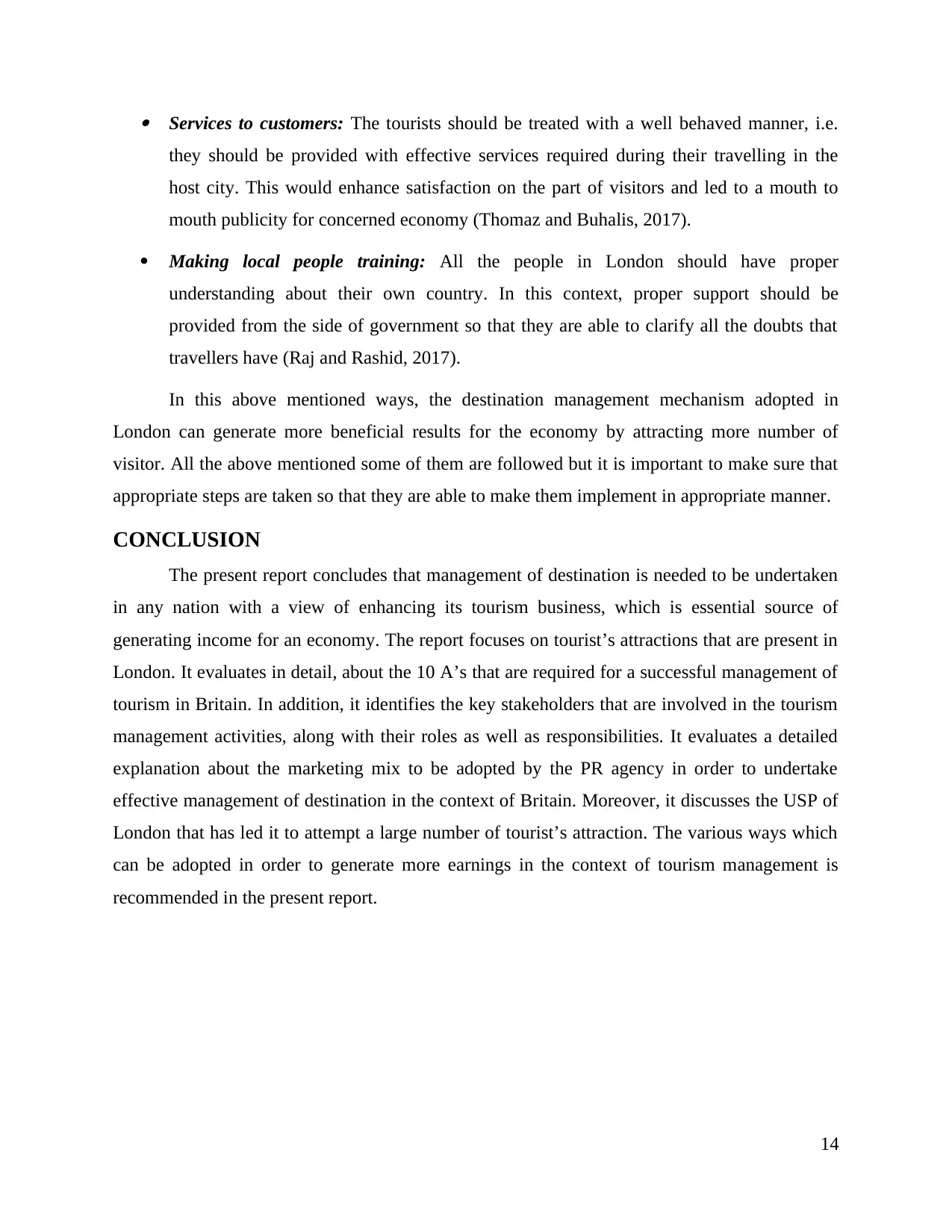
Services to customers: The tourists should be treated with a well behaved manner, i.e.
they should be provided with effective services required during their travelling in the
host city. This would enhance satisfaction on the part of visitors and led to a mouth to
mouth publicity for concerned economy (Thomaz and Buhalis, 2017).
Making local people training: All the people in London should have proper
understanding about their own country. In this context, proper support should be
provided from the side of government so that they are able to clarify all the doubts that
travellers have (Raj and Rashid, 2017).
In this above mentioned ways, the destination management mechanism adopted in
London can generate more beneficial results for the economy by attracting more number of
visitor. All the above mentioned some of them are followed but it is important to make sure that
appropriate steps are taken so that they are able to make them implement in appropriate manner.
CONCLUSION
The present report concludes that management of destination is needed to be undertaken
in any nation with a view of enhancing its tourism business, which is essential source of
generating income for an economy. The report focuses on tourist’s attractions that are present in
London. It evaluates in detail, about the 10 A’s that are required for a successful management of
tourism in Britain. In addition, it identifies the key stakeholders that are involved in the tourism
management activities, along with their roles as well as responsibilities. It evaluates a detailed
explanation about the marketing mix to be adopted by the PR agency in order to undertake
effective management of destination in the context of Britain. Moreover, it discusses the USP of
London that has led it to attempt a large number of tourist’s attraction. The various ways which
can be adopted in order to generate more earnings in the context of tourism management is
recommended in the present report.
14
they should be provided with effective services required during their travelling in the
host city. This would enhance satisfaction on the part of visitors and led to a mouth to
mouth publicity for concerned economy (Thomaz and Buhalis, 2017).
Making local people training: All the people in London should have proper
understanding about their own country. In this context, proper support should be
provided from the side of government so that they are able to clarify all the doubts that
travellers have (Raj and Rashid, 2017).
In this above mentioned ways, the destination management mechanism adopted in
London can generate more beneficial results for the economy by attracting more number of
visitor. All the above mentioned some of them are followed but it is important to make sure that
appropriate steps are taken so that they are able to make them implement in appropriate manner.
CONCLUSION
The present report concludes that management of destination is needed to be undertaken
in any nation with a view of enhancing its tourism business, which is essential source of
generating income for an economy. The report focuses on tourist’s attractions that are present in
London. It evaluates in detail, about the 10 A’s that are required for a successful management of
tourism in Britain. In addition, it identifies the key stakeholders that are involved in the tourism
management activities, along with their roles as well as responsibilities. It evaluates a detailed
explanation about the marketing mix to be adopted by the PR agency in order to undertake
effective management of destination in the context of Britain. Moreover, it discusses the USP of
London that has led it to attempt a large number of tourist’s attraction. The various ways which
can be adopted in order to generate more earnings in the context of tourism management is
recommended in the present report.
14
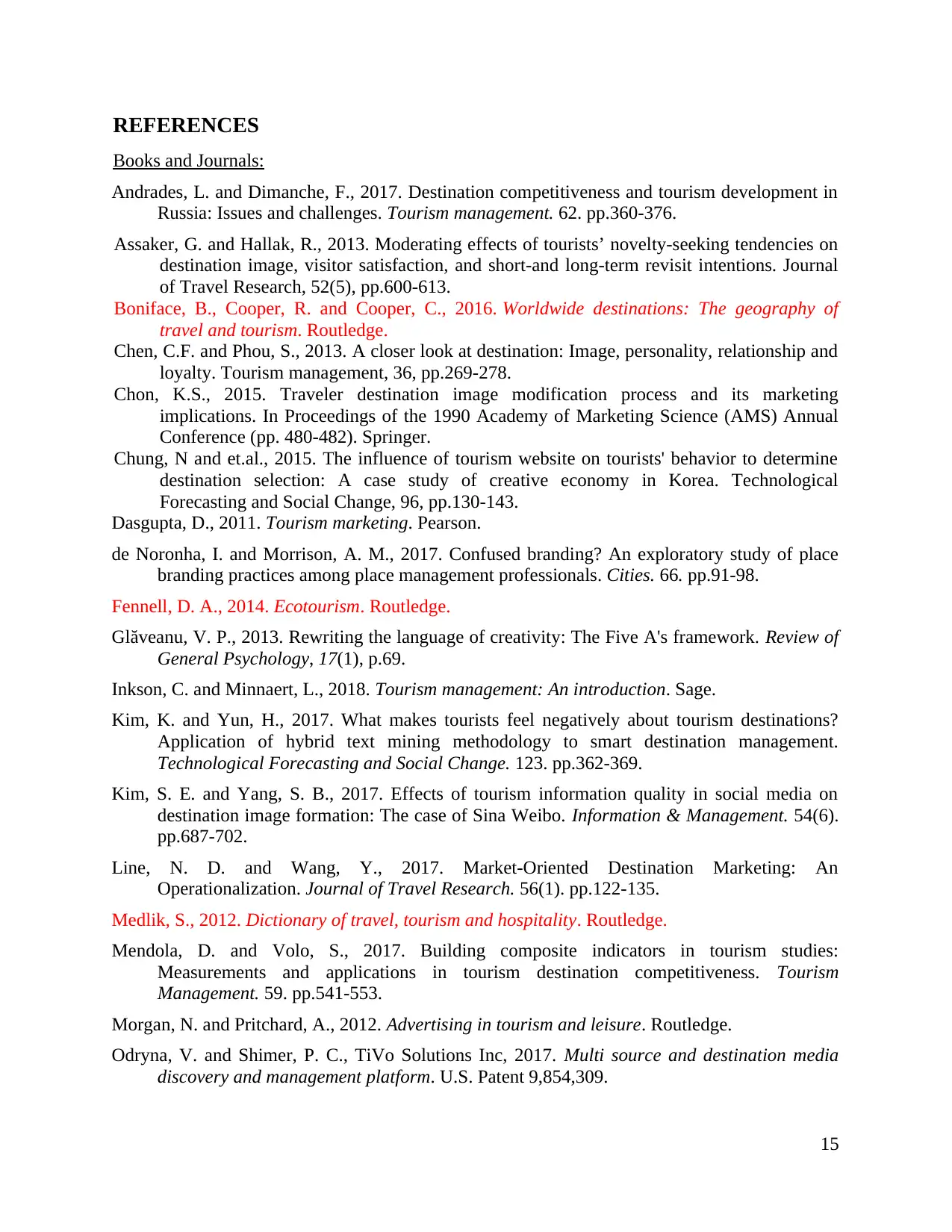
REFERENCES
Books and Journals:
Andrades, L. and Dimanche, F., 2017. Destination competitiveness and tourism development in
Russia: Issues and challenges. Tourism management. 62. pp.360-376.
Assaker, G. and Hallak, R., 2013. Moderating effects of tourists’ novelty-seeking tendencies on
destination image, visitor satisfaction, and short-and long-term revisit intentions. Journal
of Travel Research, 52(5), pp.600-613.
Boniface, B., Cooper, R. and Cooper, C., 2016. Worldwide destinations: The geography of
travel and tourism. Routledge.
Chen, C.F. and Phou, S., 2013. A closer look at destination: Image, personality, relationship and
loyalty. Tourism management, 36, pp.269-278.
Chon, K.S., 2015. Traveler destination image modification process and its marketing
implications. In Proceedings of the 1990 Academy of Marketing Science (AMS) Annual
Conference (pp. 480-482). Springer.
Chung, N and et.al., 2015. The influence of tourism website on tourists' behavior to determine
destination selection: A case study of creative economy in Korea. Technological
Forecasting and Social Change, 96, pp.130-143.
Dasgupta, D., 2011. Tourism marketing. Pearson.
de Noronha, I. and Morrison, A. M., 2017. Confused branding? An exploratory study of place
branding practices among place management professionals. Cities. 66. pp.91-98.
Fennell, D. A., 2014. Ecotourism. Routledge.
Glăveanu, V. P., 2013. Rewriting the language of creativity: The Five A's framework. Review of
General Psychology, 17(1), p.69.
Inkson, C. and Minnaert, L., 2018. Tourism management: An introduction. Sage.
Kim, K. and Yun, H., 2017. What makes tourists feel negatively about tourism destinations?
Application of hybrid text mining methodology to smart destination management.
Technological Forecasting and Social Change. 123. pp.362-369.
Kim, S. E. and Yang, S. B., 2017. Effects of tourism information quality in social media on
destination image formation: The case of Sina Weibo. Information & Management. 54(6).
pp.687-702.
Line, N. D. and Wang, Y., 2017. Market-Oriented Destination Marketing: An
Operationalization. Journal of Travel Research. 56(1). pp.122-135.
Medlik, S., 2012. Dictionary of travel, tourism and hospitality. Routledge.
Mendola, D. and Volo, S., 2017. Building composite indicators in tourism studies:
Measurements and applications in tourism destination competitiveness. Tourism
Management. 59. pp.541-553.
Morgan, N. and Pritchard, A., 2012. Advertising in tourism and leisure. Routledge.
Odryna, V. and Shimer, P. C., TiVo Solutions Inc, 2017. Multi source and destination media
discovery and management platform. U.S. Patent 9,854,309.
15
Books and Journals:
Andrades, L. and Dimanche, F., 2017. Destination competitiveness and tourism development in
Russia: Issues and challenges. Tourism management. 62. pp.360-376.
Assaker, G. and Hallak, R., 2013. Moderating effects of tourists’ novelty-seeking tendencies on
destination image, visitor satisfaction, and short-and long-term revisit intentions. Journal
of Travel Research, 52(5), pp.600-613.
Boniface, B., Cooper, R. and Cooper, C., 2016. Worldwide destinations: The geography of
travel and tourism. Routledge.
Chen, C.F. and Phou, S., 2013. A closer look at destination: Image, personality, relationship and
loyalty. Tourism management, 36, pp.269-278.
Chon, K.S., 2015. Traveler destination image modification process and its marketing
implications. In Proceedings of the 1990 Academy of Marketing Science (AMS) Annual
Conference (pp. 480-482). Springer.
Chung, N and et.al., 2015. The influence of tourism website on tourists' behavior to determine
destination selection: A case study of creative economy in Korea. Technological
Forecasting and Social Change, 96, pp.130-143.
Dasgupta, D., 2011. Tourism marketing. Pearson.
de Noronha, I. and Morrison, A. M., 2017. Confused branding? An exploratory study of place
branding practices among place management professionals. Cities. 66. pp.91-98.
Fennell, D. A., 2014. Ecotourism. Routledge.
Glăveanu, V. P., 2013. Rewriting the language of creativity: The Five A's framework. Review of
General Psychology, 17(1), p.69.
Inkson, C. and Minnaert, L., 2018. Tourism management: An introduction. Sage.
Kim, K. and Yun, H., 2017. What makes tourists feel negatively about tourism destinations?
Application of hybrid text mining methodology to smart destination management.
Technological Forecasting and Social Change. 123. pp.362-369.
Kim, S. E. and Yang, S. B., 2017. Effects of tourism information quality in social media on
destination image formation: The case of Sina Weibo. Information & Management. 54(6).
pp.687-702.
Line, N. D. and Wang, Y., 2017. Market-Oriented Destination Marketing: An
Operationalization. Journal of Travel Research. 56(1). pp.122-135.
Medlik, S., 2012. Dictionary of travel, tourism and hospitality. Routledge.
Mendola, D. and Volo, S., 2017. Building composite indicators in tourism studies:
Measurements and applications in tourism destination competitiveness. Tourism
Management. 59. pp.541-553.
Morgan, N. and Pritchard, A., 2012. Advertising in tourism and leisure. Routledge.
Odryna, V. and Shimer, P. C., TiVo Solutions Inc, 2017. Multi source and destination media
discovery and management platform. U.S. Patent 9,854,309.
15
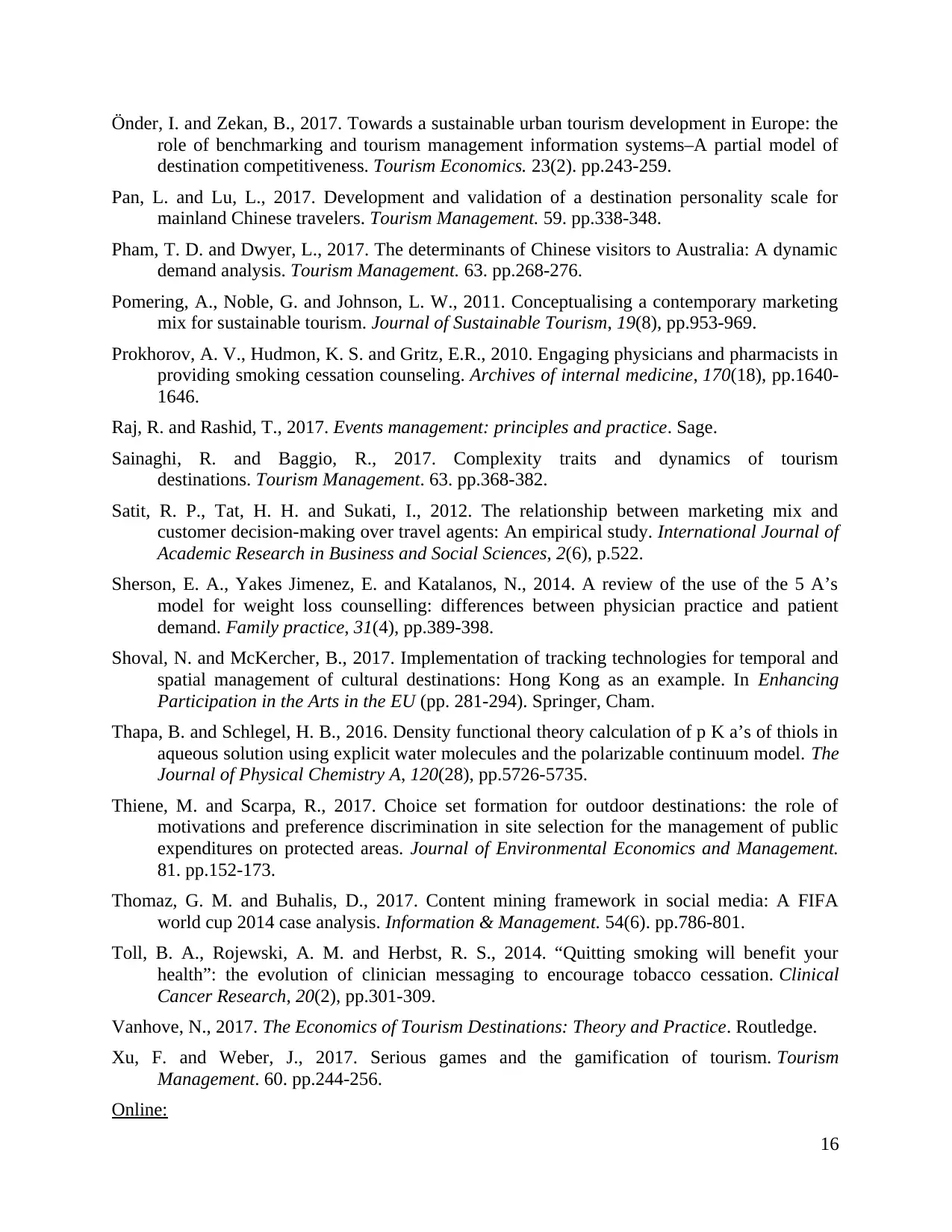
Önder, I. and Zekan, B., 2017. Towards a sustainable urban tourism development in Europe: the
role of benchmarking and tourism management information systems–A partial model of
destination competitiveness. Tourism Economics. 23(2). pp.243-259.
Pan, L. and Lu, L., 2017. Development and validation of a destination personality scale for
mainland Chinese travelers. Tourism Management. 59. pp.338-348.
Pham, T. D. and Dwyer, L., 2017. The determinants of Chinese visitors to Australia: A dynamic
demand analysis. Tourism Management. 63. pp.268-276.
Pomering, A., Noble, G. and Johnson, L. W., 2011. Conceptualising a contemporary marketing
mix for sustainable tourism. Journal of Sustainable Tourism, 19(8), pp.953-969.
Prokhorov, A. V., Hudmon, K. S. and Gritz, E.R., 2010. Engaging physicians and pharmacists in
providing smoking cessation counseling. Archives of internal medicine, 170(18), pp.1640-
1646.
Raj, R. and Rashid, T., 2017. Events management: principles and practice. Sage.
Sainaghi, R. and Baggio, R., 2017. Complexity traits and dynamics of tourism
destinations. Tourism Management. 63. pp.368-382.
Satit, R. P., Tat, H. H. and Sukati, I., 2012. The relationship between marketing mix and
customer decision-making over travel agents: An empirical study. International Journal of
Academic Research in Business and Social Sciences, 2(6), p.522.
Sherson, E. A., Yakes Jimenez, E. and Katalanos, N., 2014. A review of the use of the 5 A’s
model for weight loss counselling: differences between physician practice and patient
demand. Family practice, 31(4), pp.389-398.
Shoval, N. and McKercher, B., 2017. Implementation of tracking technologies for temporal and
spatial management of cultural destinations: Hong Kong as an example. In Enhancing
Participation in the Arts in the EU (pp. 281-294). Springer, Cham.
Thapa, B. and Schlegel, H. B., 2016. Density functional theory calculation of p K a’s of thiols in
aqueous solution using explicit water molecules and the polarizable continuum model. The
Journal of Physical Chemistry A, 120(28), pp.5726-5735.
Thiene, M. and Scarpa, R., 2017. Choice set formation for outdoor destinations: the role of
motivations and preference discrimination in site selection for the management of public
expenditures on protected areas. Journal of Environmental Economics and Management.
81. pp.152-173.
Thomaz, G. M. and Buhalis, D., 2017. Content mining framework in social media: A FIFA
world cup 2014 case analysis. Information & Management. 54(6). pp.786-801.
Toll, B. A., Rojewski, A. M. and Herbst, R. S., 2014. “Quitting smoking will benefit your
health”: the evolution of clinician messaging to encourage tobacco cessation. Clinical
Cancer Research, 20(2), pp.301-309.
Vanhove, N., 2017. The Economics of Tourism Destinations: Theory and Practice. Routledge.
Xu, F. and Weber, J., 2017. Serious games and the gamification of tourism. Tourism
Management. 60. pp.244-256.
Online:
16
role of benchmarking and tourism management information systems–A partial model of
destination competitiveness. Tourism Economics. 23(2). pp.243-259.
Pan, L. and Lu, L., 2017. Development and validation of a destination personality scale for
mainland Chinese travelers. Tourism Management. 59. pp.338-348.
Pham, T. D. and Dwyer, L., 2017. The determinants of Chinese visitors to Australia: A dynamic
demand analysis. Tourism Management. 63. pp.268-276.
Pomering, A., Noble, G. and Johnson, L. W., 2011. Conceptualising a contemporary marketing
mix for sustainable tourism. Journal of Sustainable Tourism, 19(8), pp.953-969.
Prokhorov, A. V., Hudmon, K. S. and Gritz, E.R., 2010. Engaging physicians and pharmacists in
providing smoking cessation counseling. Archives of internal medicine, 170(18), pp.1640-
1646.
Raj, R. and Rashid, T., 2017. Events management: principles and practice. Sage.
Sainaghi, R. and Baggio, R., 2017. Complexity traits and dynamics of tourism
destinations. Tourism Management. 63. pp.368-382.
Satit, R. P., Tat, H. H. and Sukati, I., 2012. The relationship between marketing mix and
customer decision-making over travel agents: An empirical study. International Journal of
Academic Research in Business and Social Sciences, 2(6), p.522.
Sherson, E. A., Yakes Jimenez, E. and Katalanos, N., 2014. A review of the use of the 5 A’s
model for weight loss counselling: differences between physician practice and patient
demand. Family practice, 31(4), pp.389-398.
Shoval, N. and McKercher, B., 2017. Implementation of tracking technologies for temporal and
spatial management of cultural destinations: Hong Kong as an example. In Enhancing
Participation in the Arts in the EU (pp. 281-294). Springer, Cham.
Thapa, B. and Schlegel, H. B., 2016. Density functional theory calculation of p K a’s of thiols in
aqueous solution using explicit water molecules and the polarizable continuum model. The
Journal of Physical Chemistry A, 120(28), pp.5726-5735.
Thiene, M. and Scarpa, R., 2017. Choice set formation for outdoor destinations: the role of
motivations and preference discrimination in site selection for the management of public
expenditures on protected areas. Journal of Environmental Economics and Management.
81. pp.152-173.
Thomaz, G. M. and Buhalis, D., 2017. Content mining framework in social media: A FIFA
world cup 2014 case analysis. Information & Management. 54(6). pp.786-801.
Toll, B. A., Rojewski, A. M. and Herbst, R. S., 2014. “Quitting smoking will benefit your
health”: the evolution of clinician messaging to encourage tobacco cessation. Clinical
Cancer Research, 20(2), pp.301-309.
Vanhove, N., 2017. The Economics of Tourism Destinations: Theory and Practice. Routledge.
Xu, F. and Weber, J., 2017. Serious games and the gamification of tourism. Tourism
Management. 60. pp.244-256.
Online:
16
Secure Best Marks with AI Grader
Need help grading? Try our AI Grader for instant feedback on your assignments.
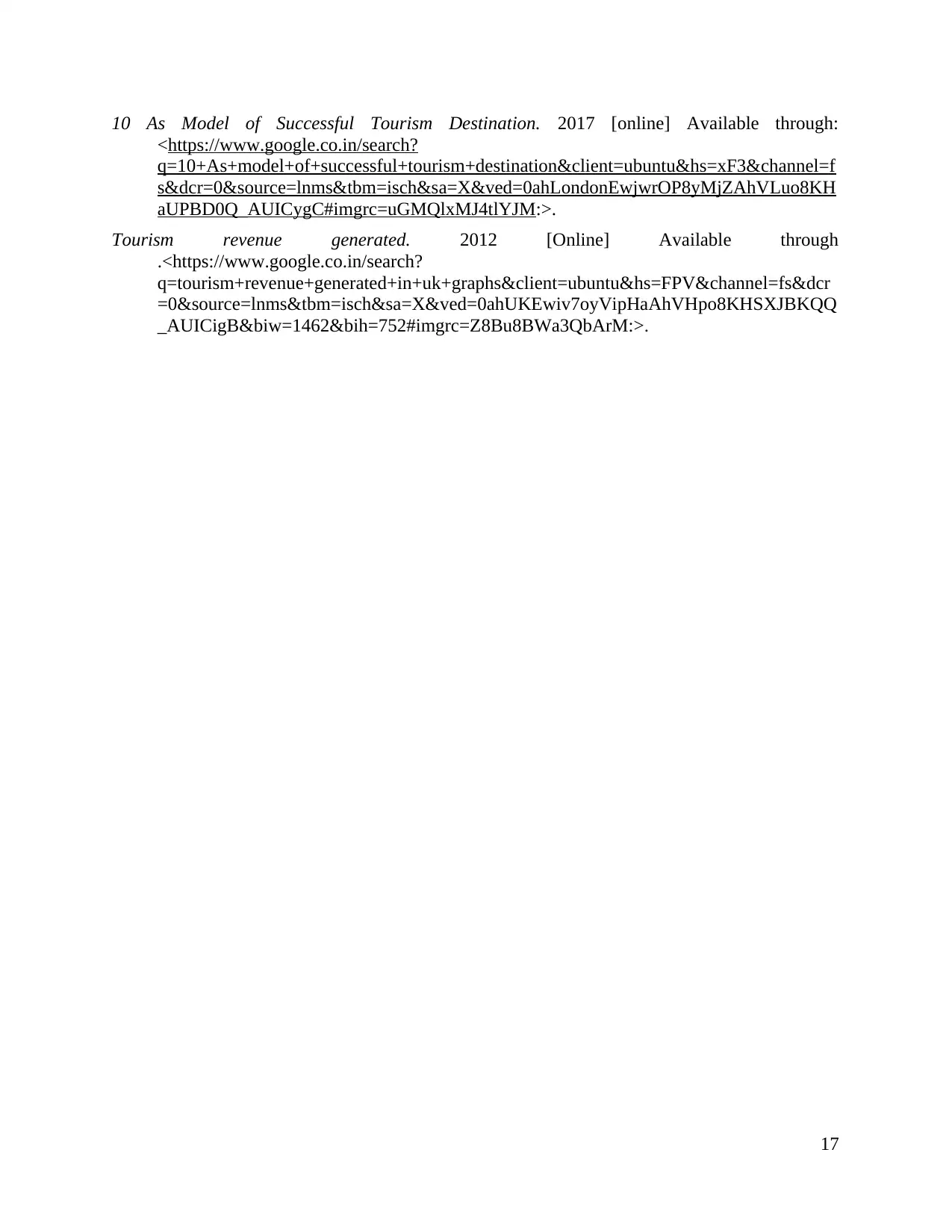
10 As Model of Successful Tourism Destination. 2017 [online] Available through:
<https://www.google.co.in/search?
q=10+As+model+of+successful+tourism+destination&client=ubuntu&hs=xF3&channel=f
s&dcr=0&source=lnms&tbm=isch&sa=X&ved=0ahLondonEwjwrOP8yMjZAhVLuo8KH
aUPBD0Q_AUICygC#imgrc=uGMQlxMJ4tlYJM:>.
Tourism revenue generated. 2012 [Online] Available through
.<https://www.google.co.in/search?
q=tourism+revenue+generated+in+uk+graphs&client=ubuntu&hs=FPV&channel=fs&dcr
=0&source=lnms&tbm=isch&sa=X&ved=0ahUKEwiv7oyVipHaAhVHpo8KHSXJBKQQ
_AUICigB&biw=1462&bih=752#imgrc=Z8Bu8BWa3QbArM:>.
17
<https://www.google.co.in/search?
q=10+As+model+of+successful+tourism+destination&client=ubuntu&hs=xF3&channel=f
s&dcr=0&source=lnms&tbm=isch&sa=X&ved=0ahLondonEwjwrOP8yMjZAhVLuo8KH
aUPBD0Q_AUICygC#imgrc=uGMQlxMJ4tlYJM:>.
Tourism revenue generated. 2012 [Online] Available through
.<https://www.google.co.in/search?
q=tourism+revenue+generated+in+uk+graphs&client=ubuntu&hs=FPV&channel=fs&dcr
=0&source=lnms&tbm=isch&sa=X&ved=0ahUKEwiv7oyVipHaAhVHpo8KHSXJBKQQ
_AUICigB&biw=1462&bih=752#imgrc=Z8Bu8BWa3QbArM:>.
17
1 out of 20
Related Documents
Your All-in-One AI-Powered Toolkit for Academic Success.
+13062052269
info@desklib.com
Available 24*7 on WhatsApp / Email
![[object Object]](/_next/static/media/star-bottom.7253800d.svg)
Unlock your academic potential
© 2024 | Zucol Services PVT LTD | All rights reserved.





